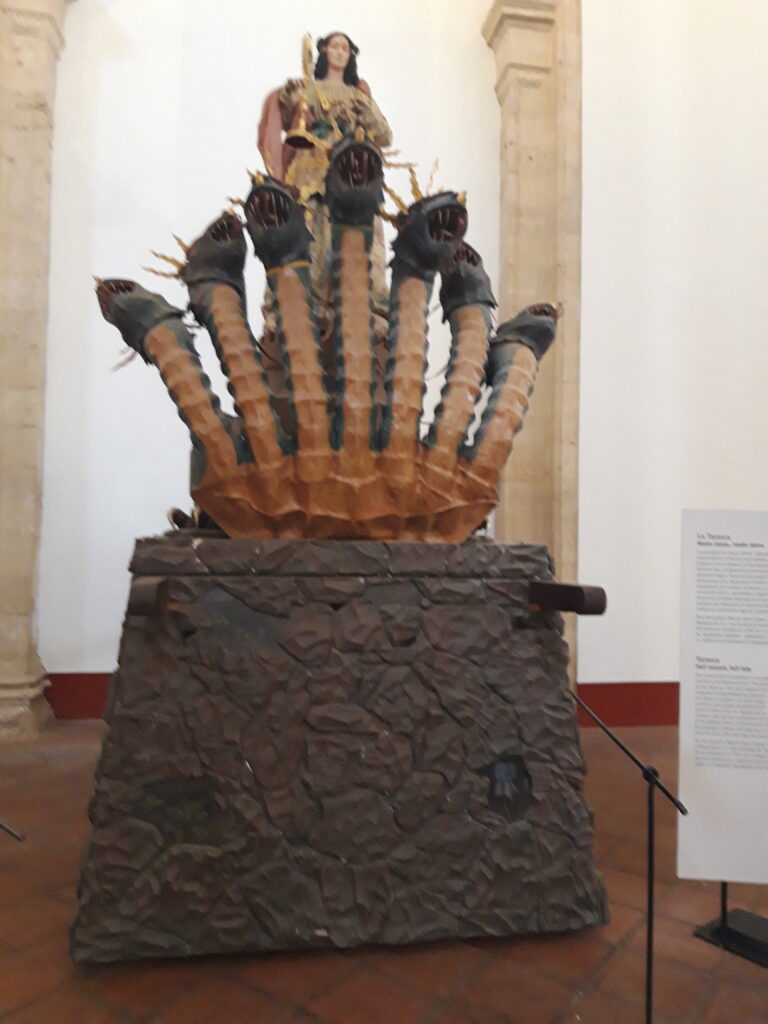
Above: The Tarasca, Antequera, España
‘Twas brillig and the slithy toves
Did gyre and gimble in the wabe;
All mimsy were the borogoves,
And the mome raths outgrabe.
“Beware the Jabberwock, my son!
The jaws that bite, the claws that catch!
Beware the Jubjub bird and shun
The frumious Bandersnatch!”
He took his vorpal sword in hand:
Long time the manxome foe he sought—
So rested he by the Tumtum tree,
And stood awhile in thought.
And as in uffish thought he stood,
The Jabberwock, with eyes of flame,
Came whiffling through the tulgey wood,
And burbled as it came!
One, two! One, two! And through and through
The vorpal blade went snicker-snack!
He left it dead, and with its head
He went galumphing back.
“And hast thou slain the Jabberwock?
Come to my arms, my beamish boy!
O frabjous day! Callooh! Callay!“
He chortled in his joy.
‘Twas brillig and the slithy toves
Did gyre and gimble in the wabe;
All mimsy were the borogoves,
And the mome raths outgrabe.

Above: Jabberwocky creatures, John Tenniel illustration for Lewis Carroll’s Alice Through the Looking Glass
In a wee village in Canton Thurgau, the name of which I cannot quite recall, there lived not long ago one of those pesky foreigners who keep a Swiss Army knife in their pocket, a scrawny walking stick and a backpack in their closet, and a weatherbeaten old carry-all for camping and all sorts of adventures.

Above: A wee hamlet by the Bodensee (Lake of Constance), Canton Thurgau, Schweiz (Switzerland)

Above: Flag of Thurgau

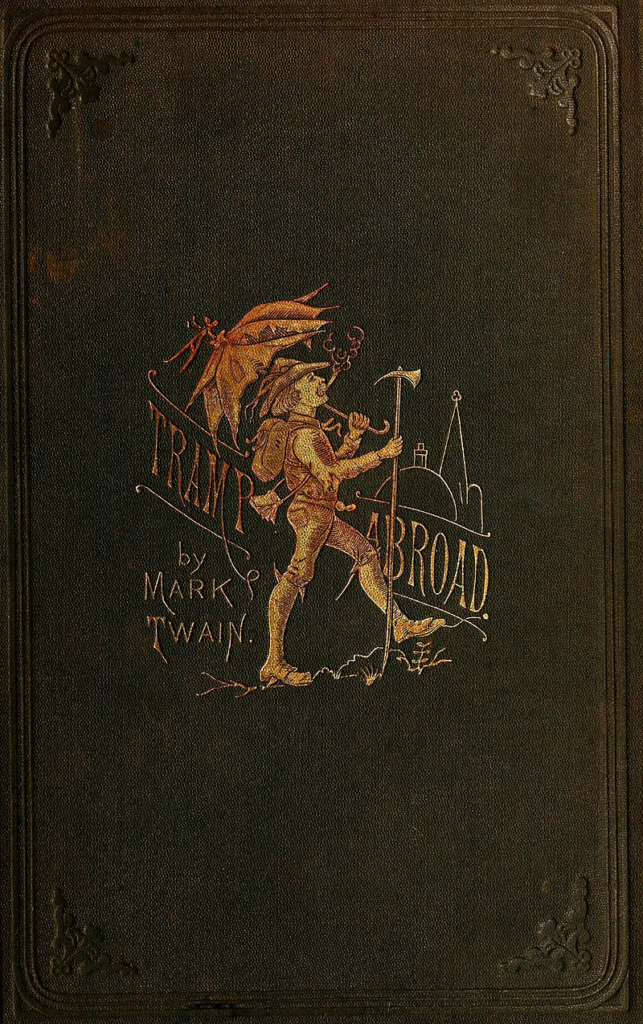
Being a Canadian of set habits, he would indulge in a hearty breakfast of bacon and eggs and toast and all sorts of wonderful accoutrements to the table such as cheese and cold cuts.
His afternoon meal would be a sort of a catch-as-catch-can affair.
Supper, when he stayed home, or dinner, when he ventured out to dine, would usually be some selection of meat and two veg in quiet commemoration of the Anglo-Saxon roots that comprise half of his home and native land.

Above: Flag of Canada
“Of good natural parts and of a liberal education.”

His income, what little there was, would be spent on cinema or literature, thus filling the flat of husband and wife with an ever-expanding collection of DVDs and books.
The Internet would slowly dissolve the need for DVDs and hard copy literature, but our hero was a stubborn man, loyal to his legacy, regardless of its breathing its last gasp of longevity.
She, the wife, was an educated woman with a professional position in a nearby hospital, but our hero was, well, more of a dreamer than a doer.
Our hero was drifting well past his mid-50s and felt that he needed a change in his lifestyle.
Her job maintained a maid outsourced to clean the flat once a week so beyond reading and writing and casually searching for work befitting his person, it was not crucial for him to actively contribute to the collective household.
Our hero was (mostly) of robust constitution, though much of his age was settling around his middle and much of his motivation was quickly dispelled by sitting comfortably until the fit of energy passed.
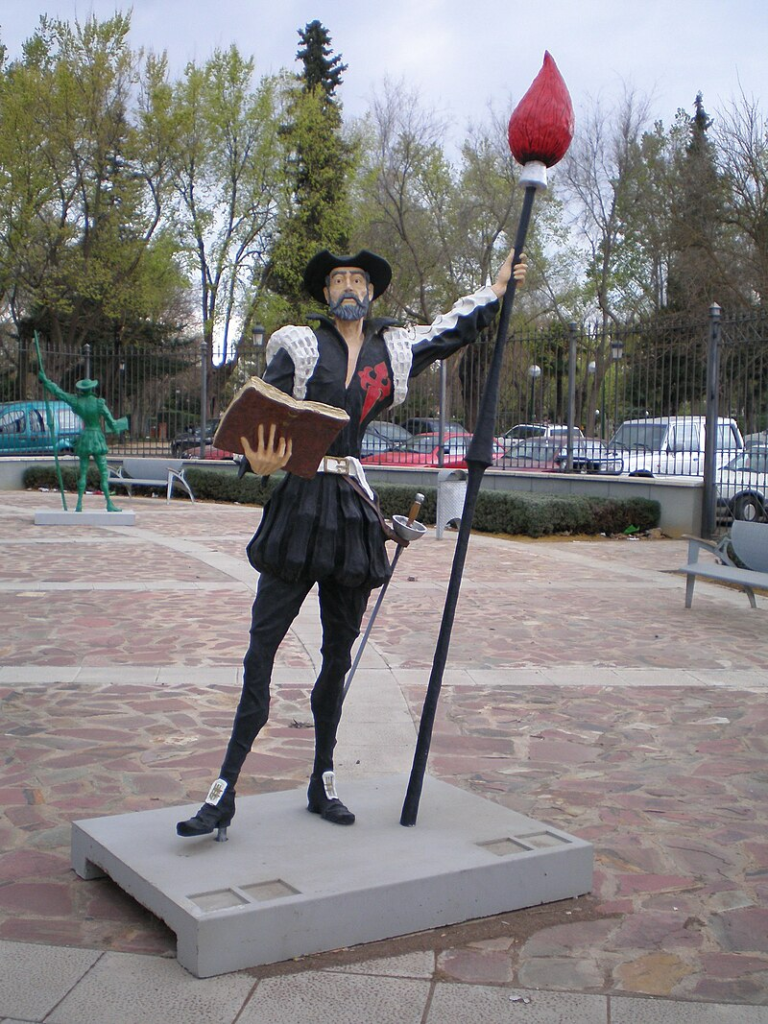
Above: Statue of Don Quixote de la Mancha, Cervantes Museum, Ciudad Real, España
“You are a King by your own fireside, as much as any monarch on his throne.“
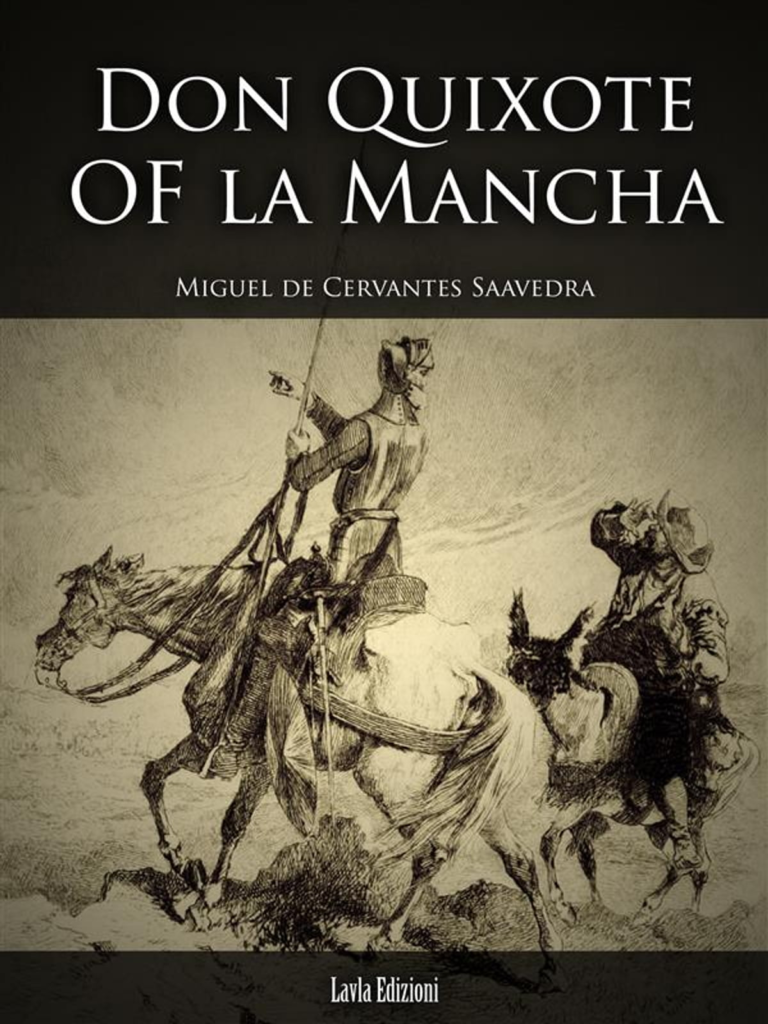
His name doesn’t matter much as far as my little tale is concerned, though I shall endeavour to stick to the meat of this tale as much as I can.
Now you must understand that during his idle moments (which were far too many for his efficient wife) our hero took to reading books of travel with such relish and enthusiasm that he almost forgot about his duties towards his wife and even his enjoyment of all the movies and music that he had collected over the years.
Our hero’s foolish curiosity reached such extremes that he would sacrifice hours of time meant for conjugal cares to spend on burying his nose in travelogues and guidebooks and maps, dreaming that Over There must, of necessity, be far superior to Right Here.
He bought as many books as he could carry home from each trip that he made to town back to their apartment, so that their tiny home was cluttered from floor to ceiling with travel books about faraway places with strange-sounding names.
He collected translations of travel literature, guidebooks in English and French (and later German), adventure literature and travel journals.

Above: Don Quixote goes mad from his reading
He knew all the great travellers, ancient and modern, from Pausanias to Paul Theroux, from Fan Chengda to Bill Bryson, from Petrarch to Bruce Chatwin.
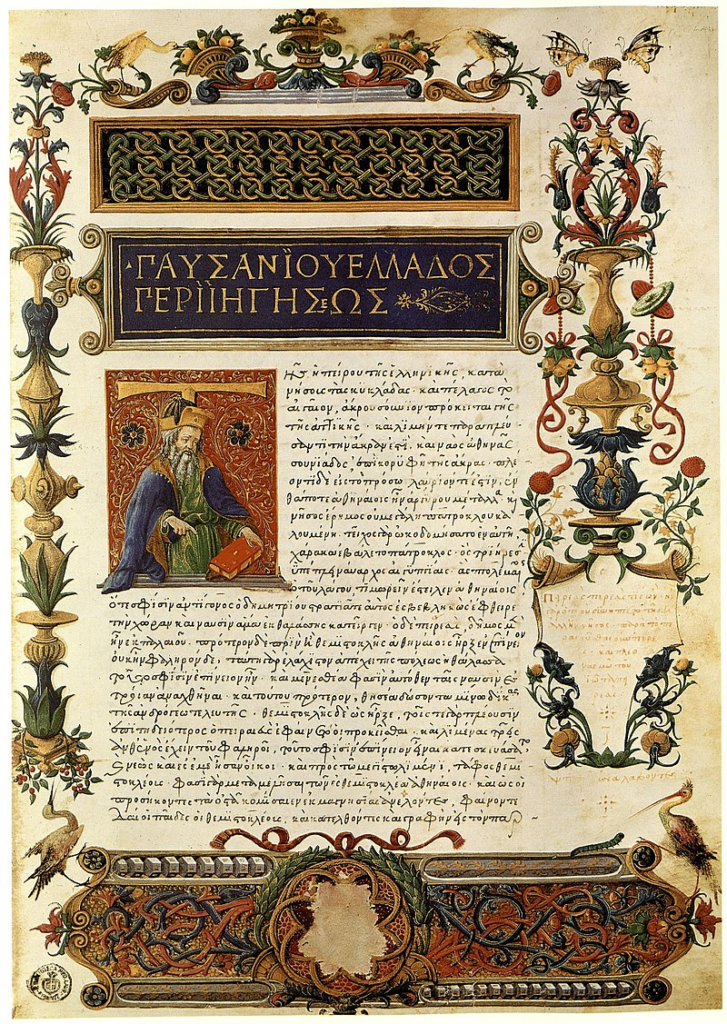
Above: The beginning of Pausanias’ (110 – 180) Description of Greece manuscript, Biblioteca Medicea Laurenziana, Firenze (Florence), Italia


Above: Chinese travel writer Fang Chengda (1126 – 1193)


Above: Italian poet Francesco di Petracco (aka Petrarch) (1304 – 1374)

Above: English writer Bruce Chatwin (1940 – 1989)
Nothing impressed him more than a life delineated by date and time of place of a visit, to the activities and sightseeing done, interactions with the locals, personal reflections and lasting impressions.

He loved brilliant prose and intricate language.
He loved the compliments these writers would label a place and the challenges these adventurers faced.
As a teacher of languages, though an ill-paid profession at best, he thoroughly detested the masquerade of multisyllabic overreaching sentences that seemed to run on past the margins of a written page.
Sentences like:
“The reason for the unreason to which my reason is subjected so weakens my reason that I have reason to complain of your beauty.”
This kind of unreasonable reasoning tests the rationale of anyone’s reason, including our reasonably rational hero.
To read a line such as:
“The lofty heavens which with their stars divinely fortify you in your divinity and make you meritous of the merits merited by your greatness.”
Well, this would cause our hero to burst out in rage:
“Plain language, please!
Show, don’t tell!“
(I pray if he ever reads this account that I give him little cause to curse and swear against my feeble attempts at fable fabrication.)

“The pen is the tongue of the soul as are the thoughts engendered there, so will be the things written.“

Such diarrhetic dialogue and description determined many a diatribe from our hero.
He would rack his brains trying to comprehend how and why these so-called wordsmiths could not form coherent sentences but would nonetheless find themselves fortunate to become published authors.
Such a puzzle not even Sherlock Holmes could unravel.

Above: Illustration of Sir Arthur Conan Doyle’s (1859 – 1930) fictional English detective Sherlock Holmes
From an early age our protagonist found himself rejecting the heroes of the comic book and screen, for no matter how many wounds were inflicted upon their persons these heroes were never scarred.
No matter how many times they seemingly died they were inevitably resurrected or it was learned that their deaths had been merely deception and misdirection to gauge our sympathy towards these unreal creations.
Despite the endless adventures promised by the superhero genre, our hero of this story preferred his role models to be flesh and blood and vulnerable to pain and death.

Still he would argue with his students as to who the better superheroes were but would remain in ignorant silence when athletes were discussed.

Above: Marvel Comics Avengers, March 2001
In short, the hero of this fable was so absorbed with travel literature that his nights were spent reading from dusk till dawn and his days from dawn till dusk, when he was not making mere pittance for the teaching he barely managed to procure.

Above: First edition of Jonathan Swift’s Gulliver’s Travels (1726)
“There is no book so bad, but something good may be found in it.“

His lack of sleep made him a poor professor.
His excess of reading withered his resolve to remain at home.
His behaviour generated rebellion in his spouse.
Her rebellion fuelled his desire to leave.

“Those who’ll play with cats must expect to be scratched.”
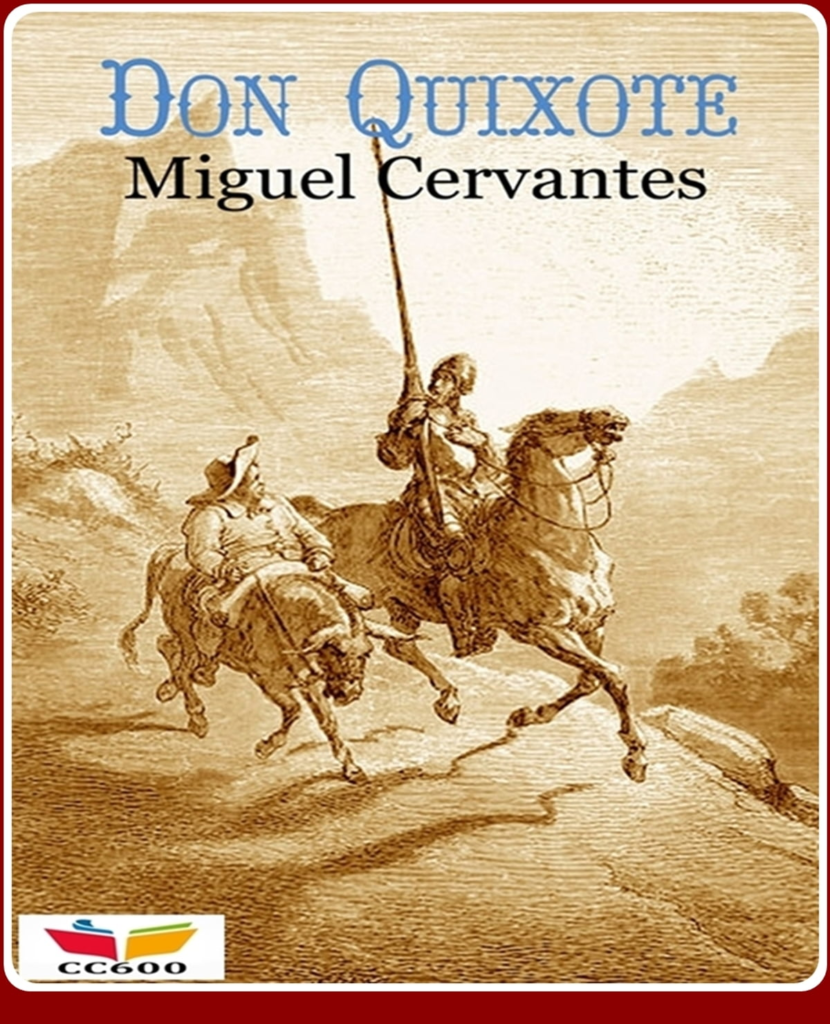
Everything he read in his books took possession of his imagination.
The idea that Adventure lay merely beyond his doorstep enchanted him.
He would fight any fight, battle any battle, challenge any challenge, bear the wounds of travel stoically as if they were naught more than sweet nothings.
He loved the open road with its storms and its impossible absurdities.
The idea that the very fabric of reality was Out There more real than the reality he dealt with Over Here so established itself in his mind that no reality in the world was truer for him than what lay beyond the horizon of his sight.
Wanderlust is a sort of insanity and creates all manner of mad machinations in a man’s mind.
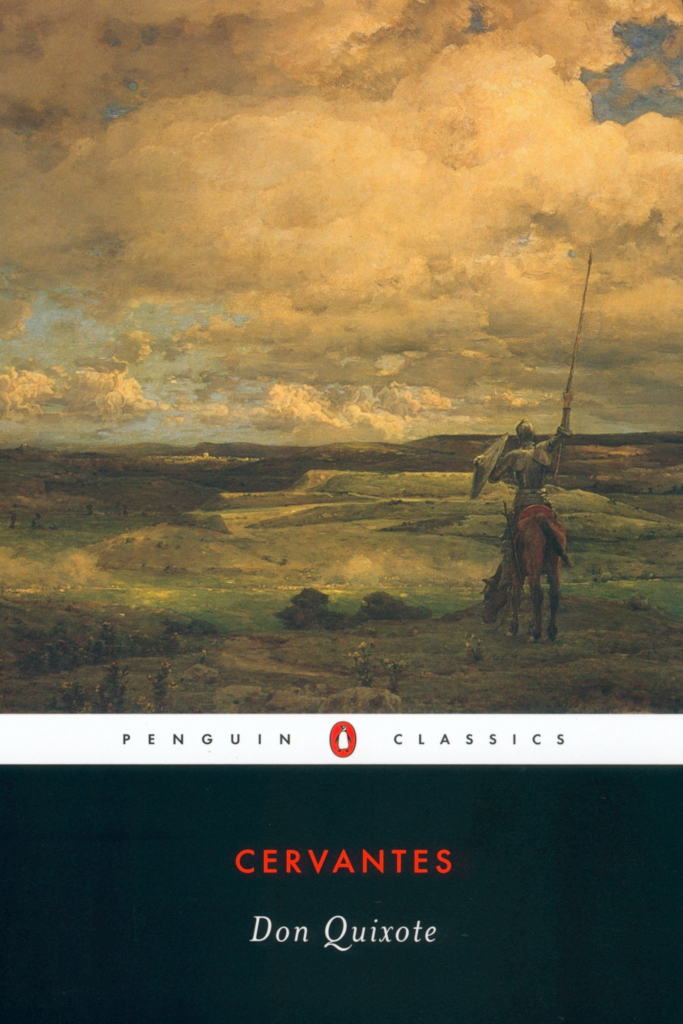
“The bow cannot always stand bent nor can human frailty subsist without some lawful recreation.”

It was deemed desirable, nay, necessary, that both for the increase of his knowledge and for the common good, that he would become a wandering nomad.
He would travel about the world armed with the most precious of his books upon his back.
He would walk the world in search of adventure.

“He who reads much and walks much sees much and knows much.”

He would see all that has been deemed worth seeing and would serendipitiously seek all that should have been seen but had not so far been properly discovered.
He would seek out wrong and expose it to the world.
He would face peril and danger without flinching.
He would gain eternal fame and fortune.
Our poor hapless hero saw himself fêted from town to town for the tales he would tell.
Possessed by these delightful dreams and carried away by the strange pleasure they gave him, he hastened to put into practice that which he so desired.

“To withdraw is not to run away, and to stay is no wise action when there is more reason to fear than to hope.
‘Tis the part of a wise man to keep himself today for tomorrow, and not venture all his eggs in one basket.
And though I am but a clown or a bumpkin, as you may say, yet I would have you to know that I know what is what and have always taken care of the main chance.“

His first step was to find a backpack of substance and history that had been worn by others before him.
In a thrift store he found one, neglected and abandoned and forgotten in a dark corner of the place, covered in dust and cobwebs.
He scoured and mended it as best as he could.

He found himself a pair of boots, a workman’s boots rather than a fancy expensive pair of hiker’s boots.

His pack he named Matilda.

(“Waltzing Matilda” is a song developed in the Australian style of poetry and folk music called a bush ballad.
It has been described as the country’s “unofficial national anthem“.
The title was Australian slang for travelling on foot (waltzing) with one’s belongings in a “matilda” (swag) slung over one’s back.
The song narrates the story of an itinerant worker, or “swagman“, making a drink of billy (cooking pot) tea at a bush camp and capturing a stray jumbuck (sheep) to eat.
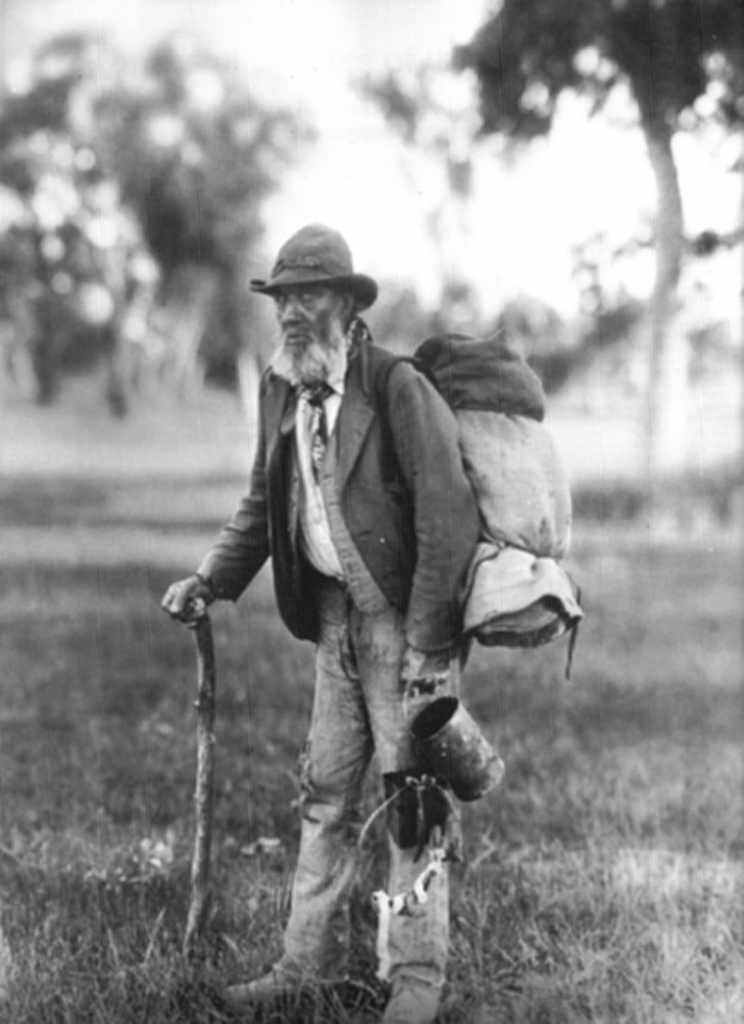
Above: Elderly swagman, 1901

Above: Traditional billycan on a campfire
When the jumbuck’s owner, a squatter (grazier), and three troopers (mounted policemen) pursue the swagman for theft, he declares “You’ll never catch me alive!” and commits suicide by drowning himself in a nearby billabong (watering hole), after which his ghost haunts the site.

Above: Billabong, Scrubby Creek, Berrinba Wetlands, Queensland, Australia
In Australia, a swag is a portable sleeping unit.
It is normally a bundle of belongings rolled in a traditional fashion to be carried by a foot traveller in the Bush.
Before motor transport was common, foot travel over long distances was essential to agriculture in the Australian Bush.
It is sometimes referred to as a “backpack bed“.
Swags have been carried by shearers, miners, the unemployed, and many others, some of whom would have been happy to have been called swagmen and some not.)

Above: A modern swag
His boots became Frick and Frack.

Above: Swiss comedic ice skating duo Werner Groebli (1915 – 2008) (aka Frick) (bottom) and Hans Mauch (1919 – 1979) (aka Frack) (top)
(Frick and Frack were a comedic ice skating duo of Swiss skaters who went to the US in 1937 and joined the original Ice Follies show.
“Frick” was Werner Groebli, born in Basel.
“Frack” was Hans Rudolf “Hansruedi” Mauch, also born in Basel.
Frick and Frack were known for often skating in Alpine Lederhosen while performing eccentric tricks on ice, including the “cantilever spread-eagle“, created by Groebli and Mauch’s “rubber legs“, twisting and bending his legs while skating in a spread eagle position.
Only a few skaters have successfully performed the duo’s routines since.
Michael Mauch, the son of Hans, described the origin of their names:
“Frick took his name from a small village (Frick, Aargau) in Switzerland.
Frack is a Swiss-German word for a frock coat, which my father used to wear in the early days of their skating act.
They put the words together as a typical Swiss joke.“
“Frick and Frack” has become an English slang term used to refer to two people so closely associated as to be indistinguishable.)
He called himself Canada Slim, though he no longer resided in Canada and (sadly) was no longer slim, but in later reflection it can be surmised that his name spoke of his lineage and his chances of success in the challenges that he would face.

Above: Canada Slim
“My memory is so bad that many times I forget my own name.“

The only remaining duty for our knight errant that I have not yet mentioned was to find a lady of whom he could be enamoured, for a knight errant without a lady love is a tree lacking leaves, forlorn without fruit, a body without a soul.
And this he had already accomplished in the choice of bride he had made decades before.
Though the harridan of the Here and Now haunted his hearth, the illusion of happiness still filled his heart with hope despite all Heaven and Hell shouting out his folly.

Men love their women.
Women merely tolerate their men.
He saw her as he wished she would and could be.
She saw him as he was and what she wished he wasn’t and shouldn’t be.

“Every man is as Heaven made him and sometimes a great deal worse.“

When they considered one another, he decided that he was delighted that he had been born a man and she knew that being a woman was far more wonderful than being a hapless man.

If I had a mind to
I wouldn’t want to think like you
And if I had time to
I wouldn’t want to talk to you
Oh-oh-oh!
I don’t care
What you do
I wouldn’t want to be like you, yeah
If I was high class
I wouldn’t need a buck to pass
And if I was a fall guy
I wouldn’t need no alibi
I don’t care
What you do
I wouldn’t want to be like you
Oh, oh, oh!
Back on the bottom line
Diggin’ for a lousy dime, yeah
If I hit a mother lode
I’d cover anything that showed
Oh-ooh-oh!
I don’t care
What you do
I wouldn’t want to be like you
Oh-ooh-oh!
I don’t care
What you do
I wouldn’t wanna
I wouldn’t want to be like you
I wouldn’t want to be like you
Yeah, oh
Yeah, oh

But despite and in spite of all their domestic difficulties, CS saw She, the Unexplicable (or U for short), She Who Must Be Obeyed, he saw her as His Lady, though She, like he, came from rural roots and though She would never grace the cover of glamourous magazines She bore the passionate and pretty pride of peasants enveloped in the purity of simplicity that wild flowers parade through fields of barley.


His love was often spoken though never fully appreciated by this Quixotic Dulcinea del D….
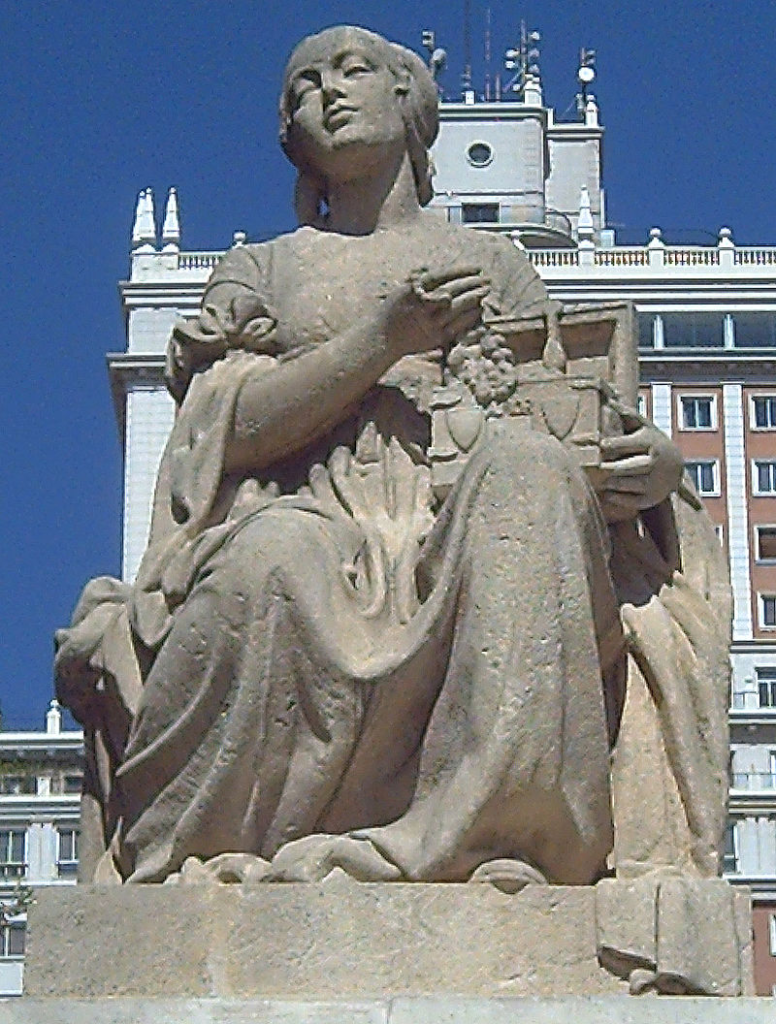
Above: Statue of Dulcinea del Toboso, Madrid, España
Her village’s name escapes me, but to him it was a name that was musical and magical and meaningful, like all the sobriquets he had bestowed upon himself and his possessions.
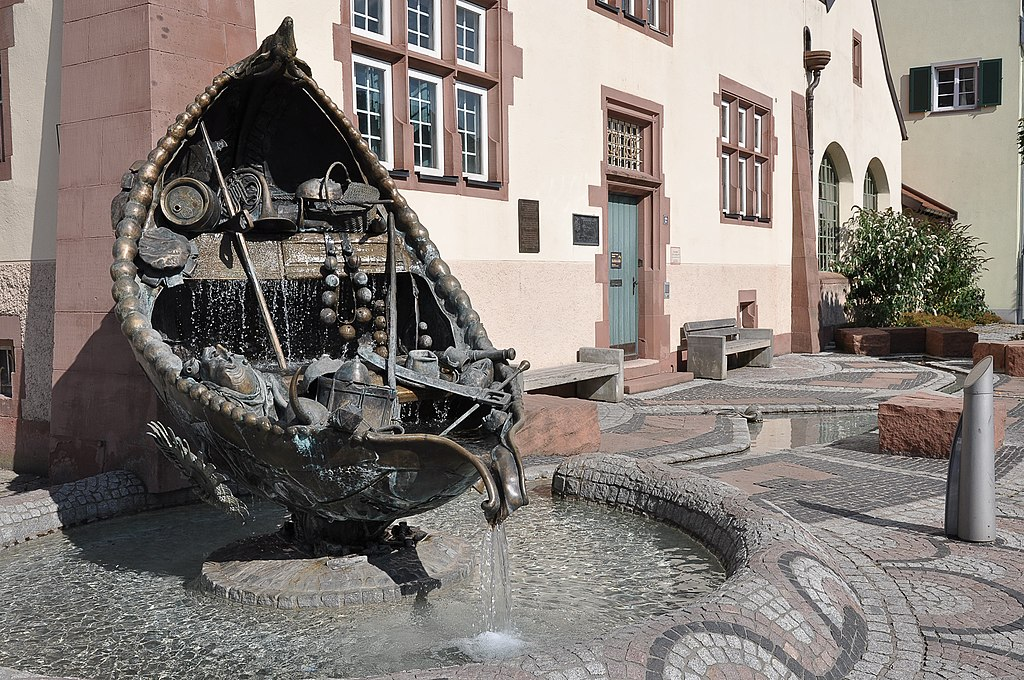
Above: Ship of Fools Fountain, Guild House, Bräunlingen, Schwarzwald Baar-Kreis, Baden-Württemberg, Deutschland (Germany)
“Absence, that common cure of love.“

He had been in his last few years underemployed as a teacher and so to appease the fair U our hero took on work that found him serving customers in a café.
Yes, his job brought some incidental income to the household, but not the salary of a teacher and certainly not the wages of a medical professional.
Our hero had stability but he could not have survived on his own without her income.
He was liked and respected by customers and colleagues but not admired by an administration more keen on profits than on promoting and developing the potential of personnel.
Our hero felt good about his capabilities in the café but he felt he could contribute far more of himself in a classroom.
There was no shame in working in a café, but, truth be told, neither was it a great honour either.
He had learned what he could and the novelty that once stimulated him no longer lingered.
He wanted to do what he loved.
He wanted to love what he did.

Above: Café de Flore, Paris, France
He had had his own adventures before falling into the foxhole of matrimony, but when all his attempts at steady gainful employment in Fortress Switzerland had failed, he resolved to venture East to its chaotic uncertainty with all its blood and sweat, tears and toil.
When an opportunity in Anatolia presented itself, he left the café, the community, the country and the fair U behind.

“The brave man carves out his fortune and every man is the son of his own works.“

Years passed.
He remained in the Turkish Republic and she continued on in the Helvetic Confederation.
They, for appearances’ sake, kept up the charade.
They remained married.
They vacationed together.
They communicated at least once a week to one another through the enigma of electronics.

“From pros and cons they fell to a warmer way of disputing.“
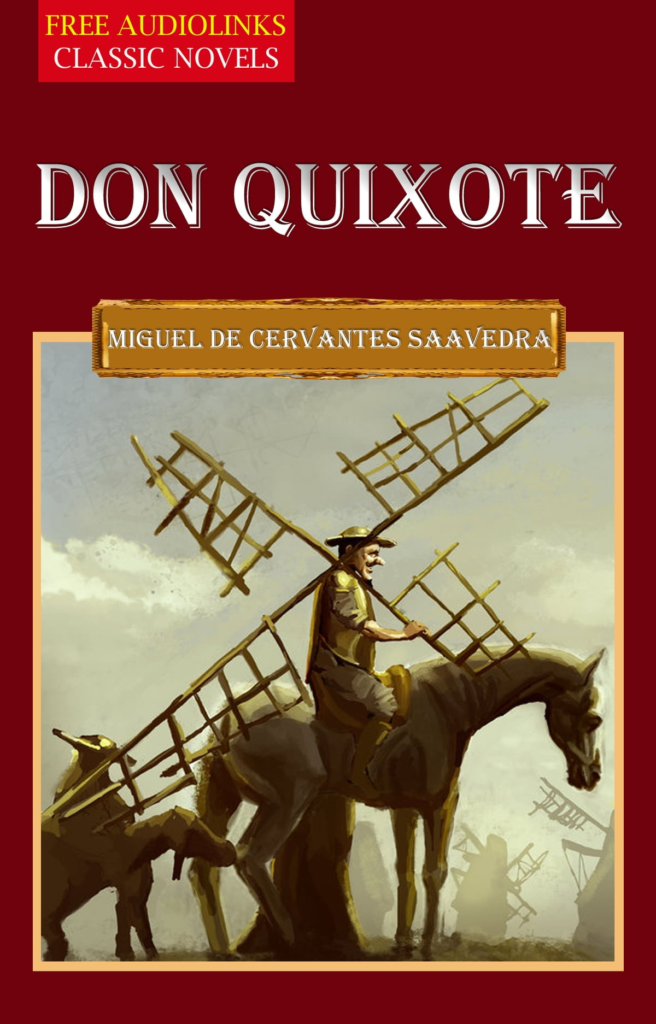
Their holidays revolved around the Islamic itinerary of Türkiye rather than the Christian calendar of Schweiz.
It was during such a Muslim moment that they journeyed together – he flew from Istanbul and she from Zürich – across the world to Andalucia and one day found themselves for an afternoon in the town of Antequera….

Above: Antequera, España
Now the lovely U and the intrepid CS had already visited the Museo de la Ciudad de Antequera with its glassware and jewellery, stone carvings and clothing, paintings and mosaics impressively displayed and expertly preserved so well that even the ornate Roman clothing looks as though it was made recently.
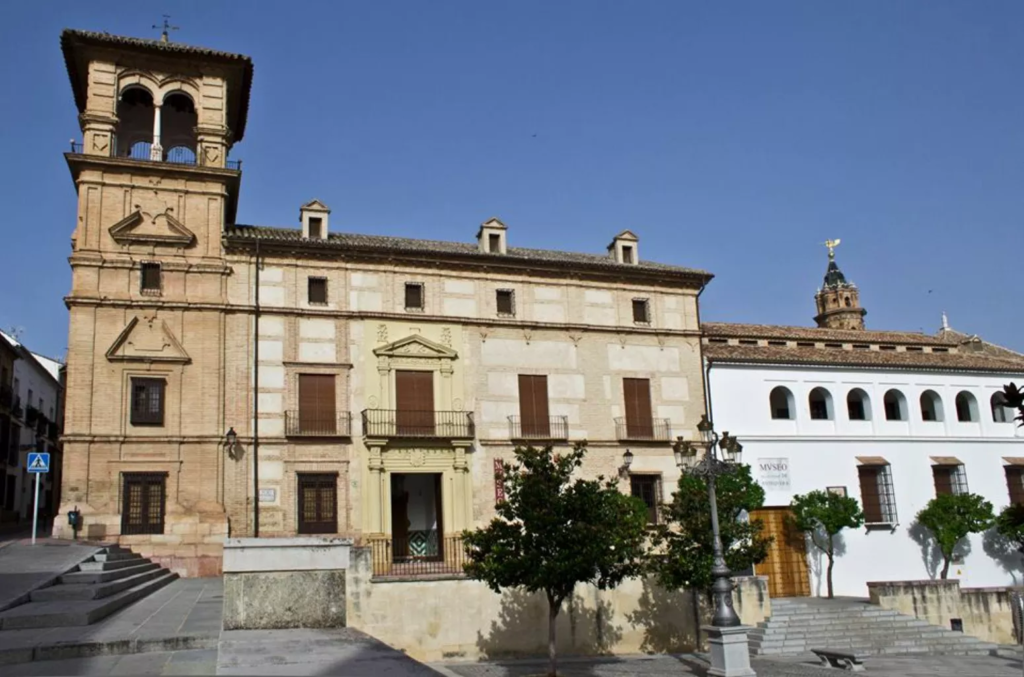
Above: Museo Antequera
It must be admitted that though he and She shared rural roots, She was naturally more sophisticated than our hero and appreciated Ephebe, the elegant and athletic 1.4m bronze statue of a naked boy, far more than he ever could.

Above: Ephebe of Antequera
They had read of the Convento de Belén, of course.
Many nuns in the convents of Spain earn their living selling confectionary.
Preserved over the ages, their recipes come from the times of the Romans and Moors.
Unfortunately, convents close and art gets lost.
The Convento de Belén is run by a cloistered order of Poor Clares.
To buy sweets, enter a tiny room with a lazy Susan installed on the wall, with a buzzer and price list next to it.
When you have decided on your purchase, ring the buzzer.
After a while – Eternity is measured differently in a nunnery. – you will hear the voice of a nun greet you.
Tell her what you would like.
After a few minutes, the lazy Susan turns to reveal your order.
Take it.
Put money on the Susan.
Spin the Susan back to the nun.
It takes a while to acquire the habit, but, God willing, you will see the sense of it all.
But divine Providence did not lead them this day to the Convento.
Instead they found themselves rambling over ruins.

Above: Convento de Belén, Antequera, España
The imposing Alcazaba, the castle of Antequerra, on Calle de los Herradores, is a superbly restored Moorish fortress that looms over Antequera from its dominant hillside position.
The Alcazaba of Antequera was erected over Roman ruins in the 14th century to counter the Christian advance from the north.
This purposefully positioned Moorish fortress was of great strategic and military importance.
Favoured by the Granada emirs of Islamic times, Antequera’s hilltop Moorish fortress has a fascinating history and covers a massive 62,000 square metres.
Both sides were aware of its vital role in the overall battle for the Kingdom of Granada.
Under Christian invasion the Alcazaba stood firm until 16 September 1410.
The fortress is rectangular in shape, with two towers.
Its keep (Torre del homenaje) is considered amongst the largest of al-Andalus, with the exception of the Comares Tower of Granada’s Alhambra.
It is surmounted by a Catholic bell tower / chapel (Templete del Papabellotas) added in 1582.
Connected to the former by a line of walls is the Torre Blanca (“white tower“).
The castle area is worth visiting because of the beautiful view of the town.
There is an entry fee and audio guide to the castle and church.

Above: Alcazaba and the Rock of the Lovers, Antequera, España
I gaze up into the sky.
The sun obscures my view.
I cannot discern Heaven from Earth.
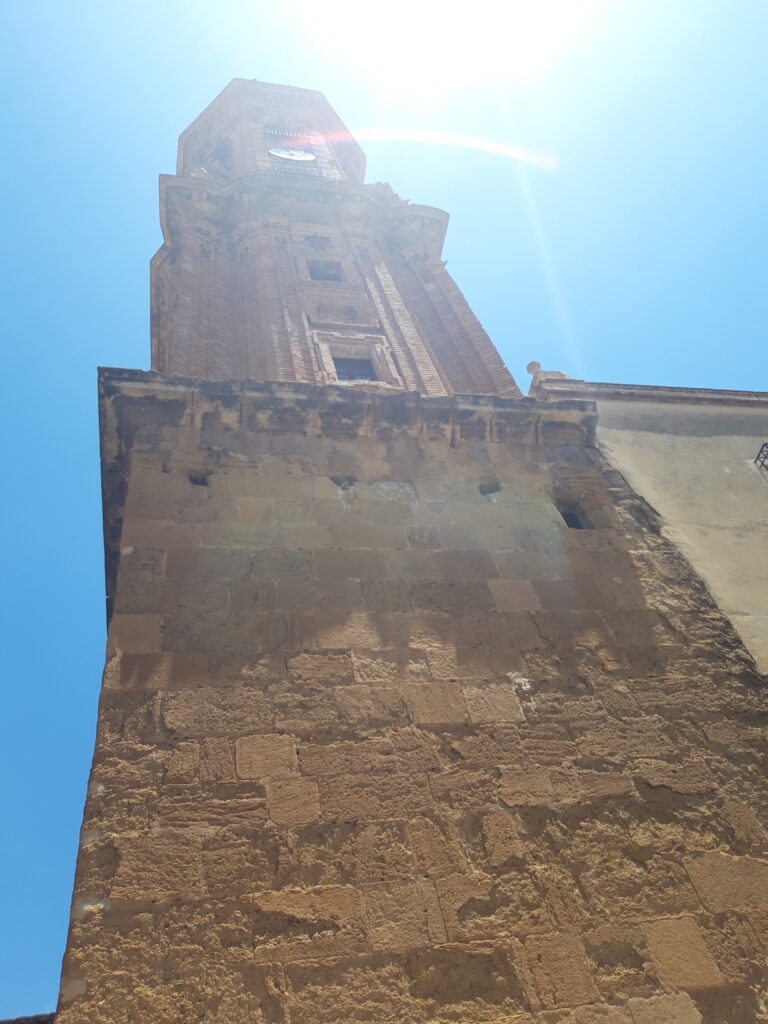
I climb.
I mount stairs in the heat of an Andalusian summer afternoon.
The view that greets me stirs me.
Antequera is an appealing place.
In the distance, the mountain that resembles a hawk-nosed Indian beckons.
Up, ascend, scale, clamber.
The older man and the younger woman, the grump and the lovely lady, advance, ascend.
Stairs skipped by her are met with groans by him.
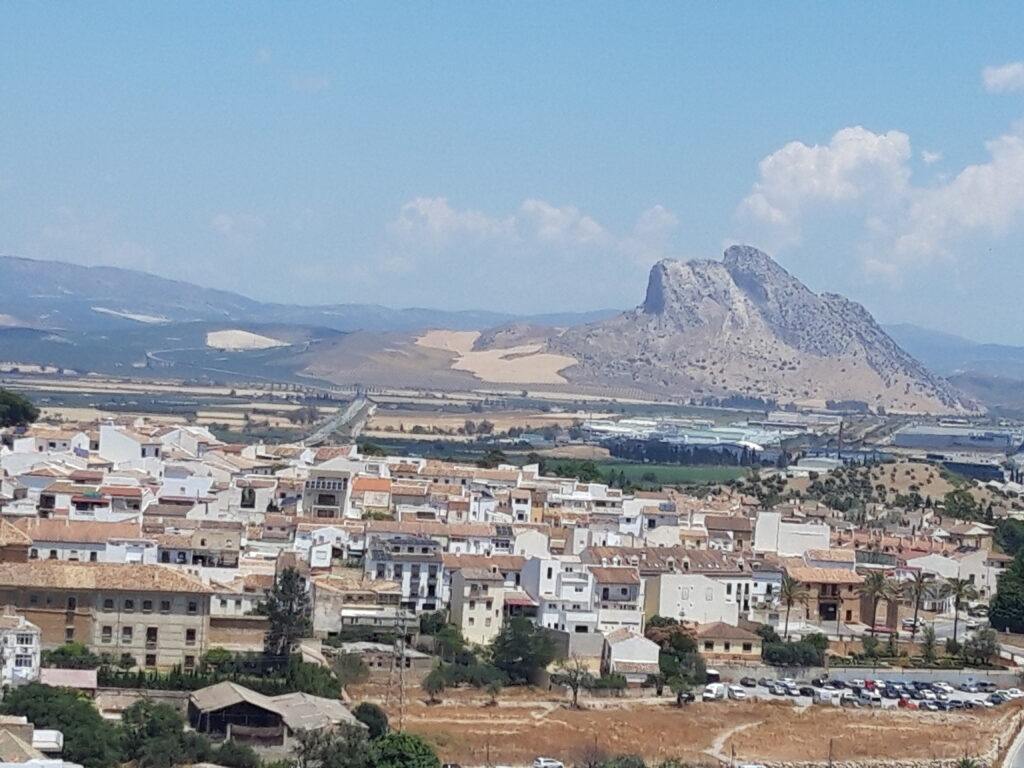
The Alcazaba of Antequera is a citadel located in the town of
Antequera.
It was declared a Site of Cultural Interest in 1985.
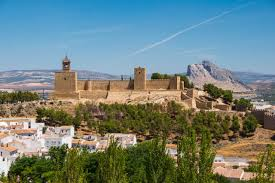
Its origins may date back to Roman times, although it is first mentioned in the 11th century writings of Semuel ibn Nagrella (993 – 1055), a Jewish poet of Badis, the 3rd King of the Taifa of Granada.

Above: Dirham of Badis ben Habus
This date coincides with the Almohad domination when two rings of walls were built that are still standing today.
These walls prevented conquest by the Castilian monarch Pedro I in 1361, being called a “strong city“.
After this event, the defenses were reinforced.

Above: Statue of Castilian King Pedro I the Cruel (1334 – 1369)
A bitter five month long siege was carried out by the Infante Don Ferdinand.
His name is now borne by the main street in Antequera:
Calle Don Infante.
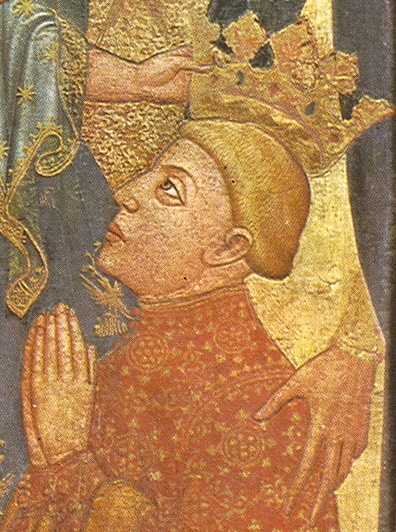
Above: Aragon King Fernando I the Just (1380 – 1416)
In order to succeed in this great siege Ferdinand had to raise an enormous army for the standards of the day of 15,000 men, as Moorish troops had come in reinforcement from Malaga and Granada, to help defend Antequera.
Infante Don Ferdinand was later known as Ferdinand of Antequera after his crucial conquering of the city.
It was considered the greatest Christian triumph prior to the conquest of Granada.
Antequera was the last city to fall before Granada.
The city and its citadel finally fell into Christian hands during the Capture of Antequera that lasted five months in 1410, in what was later considered as “the greatest triumph of the Christian between the Battle of Salado and the conquest of Granada“.
The regent Fernando de Trastámara, who governed Castile at that time, pronounced the famous phrase before the fortress was eventually won:
“Let the sun rise over Antequera and be what God wants.“
Let the sun rise over Antequera remains a saying used to express uncertainty about the outcome of an action, but determination to carry it out regardless.

Above: Antequera, España
The Siege of Antequera in 1410 was a Castilian-Leonese victory over the Nasrid garrison of this city.
The victory gave great prestige to the Infante Ferdinand of Castile, facilitating his succession to the throne of Aragon, which concluded in the Compromise of Caspe in 1412.

Above: Florin of Fernando I de Aragón
The Battle of Antequera was also called the Battle of the Horns, because horns, hooves and other animal remains that were difficult to burn and very smoky were used in it, whose acrid fumes sowed disorganization in the Arab ranks.
In 1410, Prince Ferdinand of Castile, regent of John II of Castile, decided to undertake a major campaign against the Nasrids after a few months of truce.

Above: Juan II de Castilla (1405 – 1454)
In February, Don Ferdinand began his march towards the border, going from Valladolid, where the Court had spent the winter, to Extremadura, and from there to Córdoba, where he received news of the fall of Zahara de la Sierra to the Granadans, who killed 114 men and took the women and children captive.


Above: El punete de Alcántara, Extremadura, España

Above: Images of Córdoba, España
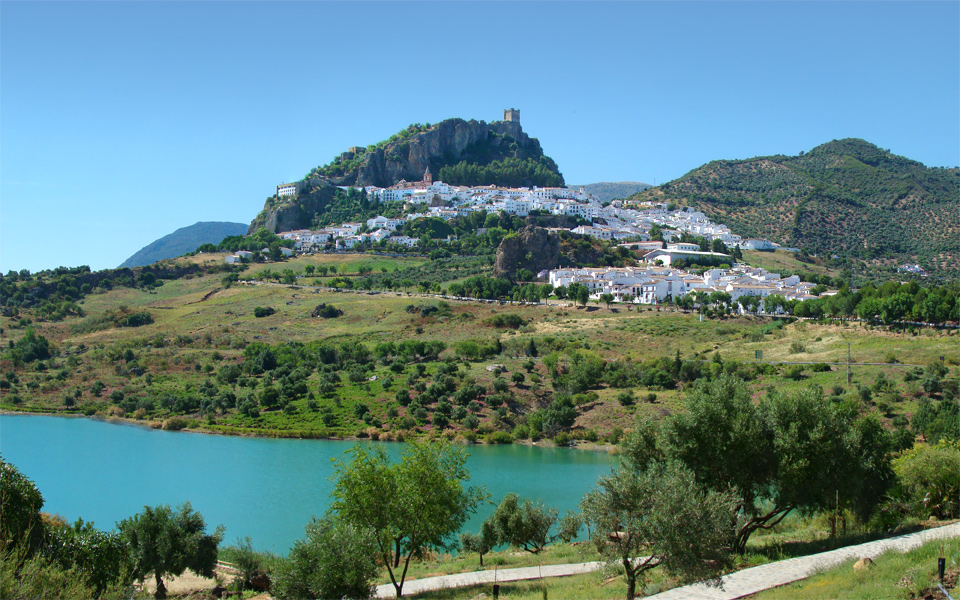
Above: Zahara de la Sierra, España
The fortress had resisted defended by only 20 men, but the culprit of the disaster was a squire named Antón Fernández de Beteta, who sold key information to the Muslims.
On 24 April 1410, the Christian leaders, gathered in Alhonoz, decided to attack Antequera, although they would wait until the spring rains had passed and they had gathered sufficient troops and equipment.
However, Prince Ferdinand, eager for a quick victory that would increase his fame, would not listen to reason and immediately left for Antequera, where he arrived on the 26th.
After surrounding the town, he was in charge of bringing the necessary siege material from Sevilla.

Above: Monumental Plaza de España, Sevilla, España
To end the siege before the Christians entrenched themselves, King Yusuf III of Granada quickly mobilized 5,000 knights and 80,000 infantrymen who, led by the infantrymen Sidi Ali and Sidi Hamet, arrived at Archidona on the afternoon of 4 May 1410.

Above: Yusuf III de Granada (1376 – 1417)

Above: Archidona, España
The next day they approached Antequera, where several skirmishes occurred.
On 6 May 1410 a bloody battle took place, when the Granada infantry charged the Christian positions in the Sierra de la Rábida, commanded by the Bishop of Palencia, Sancho de Rojas.

Above: Statue of Bishop Sancho de Rojas (1369 – 1422)
The battle was indecisive until Prince Ferdinand arrived with the bulk of his army, sending the enemy into disarray.
15,000 Muslims died and only 120 Christians, but the survivors preferred to dedicate themselves to stealing from the corpses and the Granadan camp rather than pursuing the defeated.
After the disaster, the Emir of Granada tried to arrange peace through his ambassador, Zayd Al-Amín, but the Castilian regent refused, determined as he was to obtain a great victory that would open the doors to the Aragonese throne.
On 12 May 1410, the siege team finally arrived and frantic activity began.
After some delays, the general assault took place on 27 June 1410, but it was a failure:
The ladders proved too short for the walls of Antequera and the defenders managed to burn a bastide.
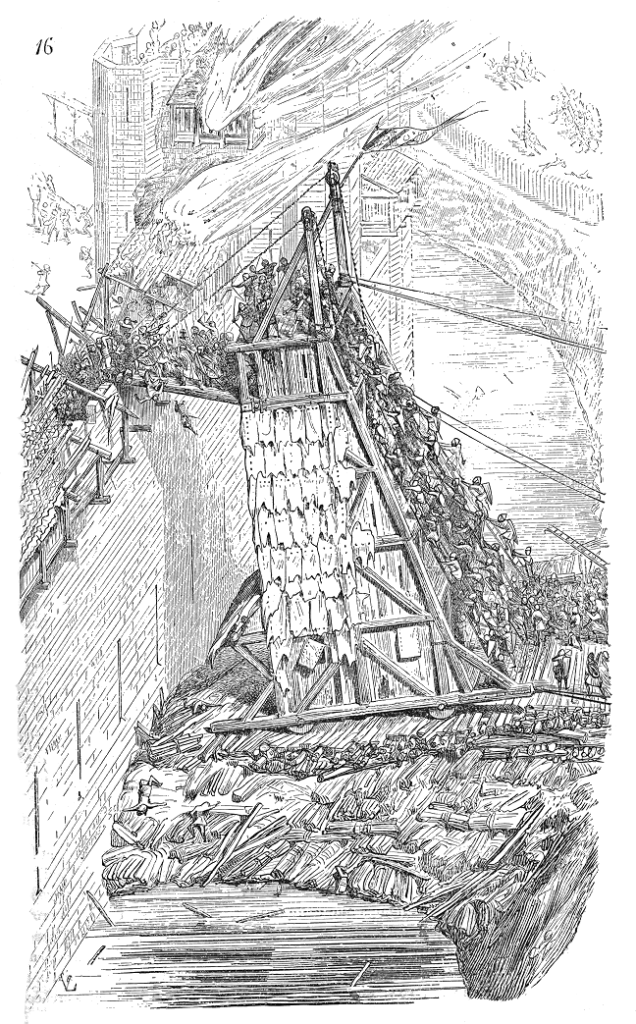
Above: Bastide
To entertain the troops while the siege equipment was renewed and to keep the enemy at bay, the Infante Fernando undertook a series of raids around Antequera:
A foray was made in Loja and another in Ronda, which resulted in a defeat and was soon avenged by breaking up an ambush of the Moors of Ronda.

Above: Loja, Granada, España

Above: Ronda, Málaga, España
On 11 July 1410, a powerful cavalry force was sent out which for five days caused havoc in the lands of Málaga, defeating the troops that came out to meet them.

Above: Flag of Málaga
Meanwhile, on the border of Jaén, Alonso Fernández de Córdoba defeated the much superior forces of the son-in-law and vizier of the Granadan king, Mofarrax , at the Battle of Montefrío, killing the Nasrid commander and taking his standard.

Above: Spanish Cardinal Alonso Fernández de Córdoba (1653 – 1699)
The Emir of Granada again asked for peace, sending Zayd Al-Amin again, but Ferdinand demanded some leonine conditions:
To declare himself a vassal of Castile, pay large tributes and free all Christian captives.
Faced with these unacceptable demands, the Granadan ambassador tried to conspire with some Muslim Castilian subjects to burn the besiegers’ camp, but the perfidy was discovered.
However, strong winds rendered the fortified walls useless, forcing the assault to be postponed again.
While spare parts were brought in, the siege of the town was completed with a wall and additional funds were requested to finance the operations.
In mid-summer news arrived of the death of the King of Aragon, Martin I the Humane, whom the Prince intended to succeed.
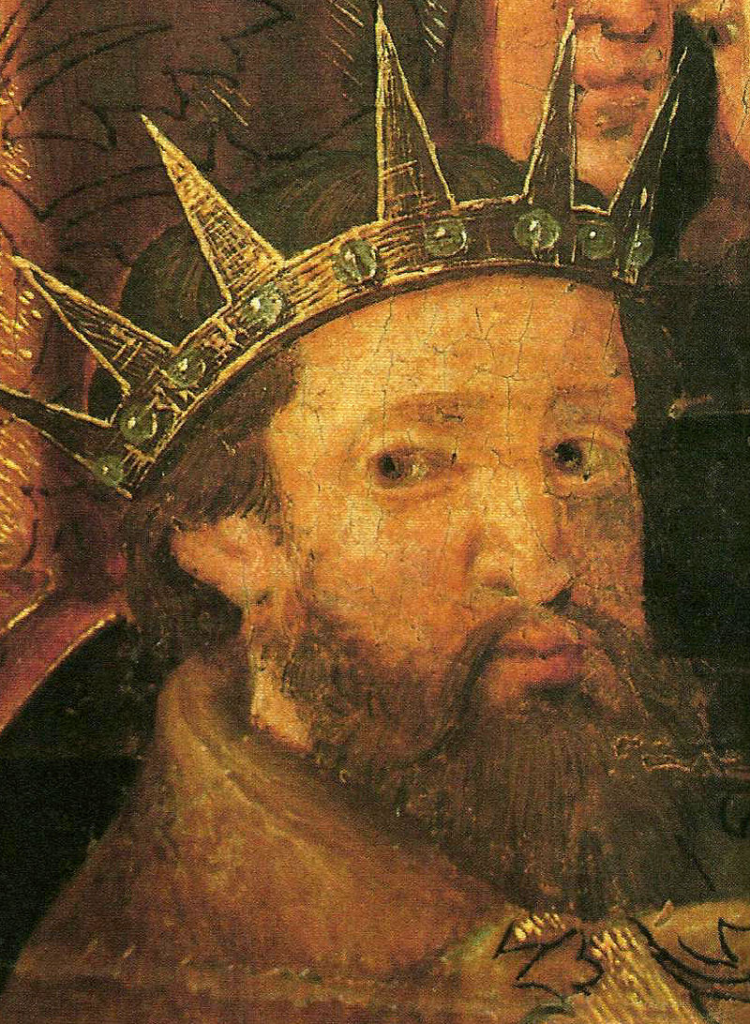
Above: Martín I de Aragón the Humane (1356 – 1410)
However, the siege did not advance beyond some victorious skirmishes.
But on 2 September 1410 the besiegers succeeded in depriving the city of its water supply.
On 10 September 1410 the Pendón de San Isidoro de León arrived, which raised Christian morale.

Above: Pendón de San Isidoro de Léon
In the following days, as skirmishes continued around the site, a stratagem was devised.
From the tops of the fortified walls, the Christians began to fire on the guards who were watching from the top of the towers, until the defenders stopped manning them to avoid the numerous casualties.
Taking advantage of the opportunity, on the night of 16 September 1410, several Christian soldiers descended from a fortified wall to the most exposed tower and took it.
A fierce hand-to-hand fight then began in the town, forcing the defenders to retreat to the citadel, where they asked to negotiate the surrender of the fortress in exchange for their lives, families and property.
The Prince urged them to surrender and free all the Christians, but they replied that they preferred to die rather than surrender.
After negotiations were resumed, the Count of Trastámara and Bishop Rojas convinced the regent to accept the conditions of the besieged in exchange for the release of the captives, since the weather was getting worse and the fortress could still resist for a long time.
Therefore, it was agreed to respect their lives and property and allow them to withdraw to Archidona, for which they were lent 1,000 beasts of burden.

Above: Coat of arms of Trastámara
On 24 September 1410 the Count and the Bishop took possession of the citadel.
The next day the last defenders left:
895 men with 770 women and 863 children.
In the following days they sold to the Christians the goods they could not transport and marched in peace to Archidona, which would be taken by Pedro Girón in 1462, although some died on the way.

Above: The Cross of Calatrava
At the beginning of October 1410 the main mosque was consecrated as the Church of Santa Eufemia.
The retreat towards Seville began.
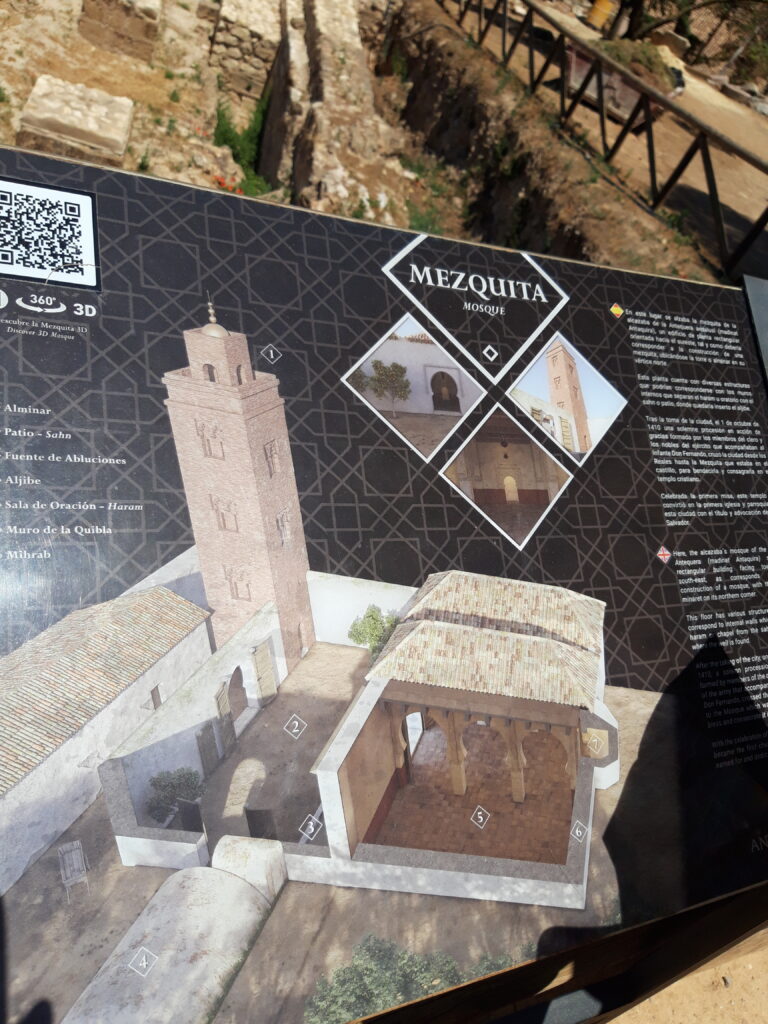

Above: Iglesia de Santa Eufemia, Antequera
On 14 October 1410 a lavish reception took place in the capital of Sevilla.
Infante Fernando came to be called “the one from Antequera” in recognition of his victory.
The high cost of the siege of Antequera prevented the war from continuing, although the Benimerines proposed an alliance against the Nasrids.
On 10 November 1410, a 17-month truce was agreed with Granada, thus saving 20 million maravedis in maintaining the army and achieving the liberation of 300 Christian captives.
The Prince, freed from his concerns in the south, was able to devote himself fully to obtaining the throne of Aragon, which he achieved in the Compromise of Caspe in 1412.

Above: Original notarial act of the unanimous election of Ferdinand of Antequera as King of Aragon by the nine delegates of Caspe, 28 June 1412
The main approach to the hilltop is from Plaza de San Sebastián, up the steps of the Cuesto de San Judas and then through an impressive archway.
The Arco de los Gigantes (Arch of the Giants), is situated at the entrance to the Alcazaba, near the Royal Collegiate Church of Santa María la Mayor in Plaza Escritores beneath the fort.
The Arco was built in the late 16th century to replace a Moorish gate.
It was erected as an artistic symbol of the Roman past of Antequera and its surrounding region.
It was adorned with sculptures of Hercules, plaques and other Roman remains.
All that remains are the remnants of Roman inscriptions on the stones.

Above: Arco de los Gigantes, Antequera, España
The Romans formerly named the city Antikaria.
There is now a three-star hotel and private businesses that carry that name in their logos.

Above: Antequera, España
The Arch is a fine example of Renaissance thinking, although now all that remains of the ornamentation is a sculptured jar of lillies, a lion, and a tower – emblems of the city.
The Arch has a two-meter thick wall, and is seven meters in height.

Above: Arco de los Gigantes, Antequera, España
The Alcazaba’s keep has an angular plan and is considered to be the widest of the Andalusian Muslim towers, with the exception of the Calahorra in Gibraltar.
Climb the 50 steps of the Torre del Homenaje for great views, especially towards the northeast, of the Peña de los Enamorados (Rock of the Lovers) – a rock whose profile resembles a human face, long the subject of local legends.
The Antequera tower is crowned with a small temple-bell tower built in 1582 to house the city’s bell and clock.
From the time of its construction it has been known as the Papabellotas Clock, because the city had to sell a cork forest of to cover the costs incurred.
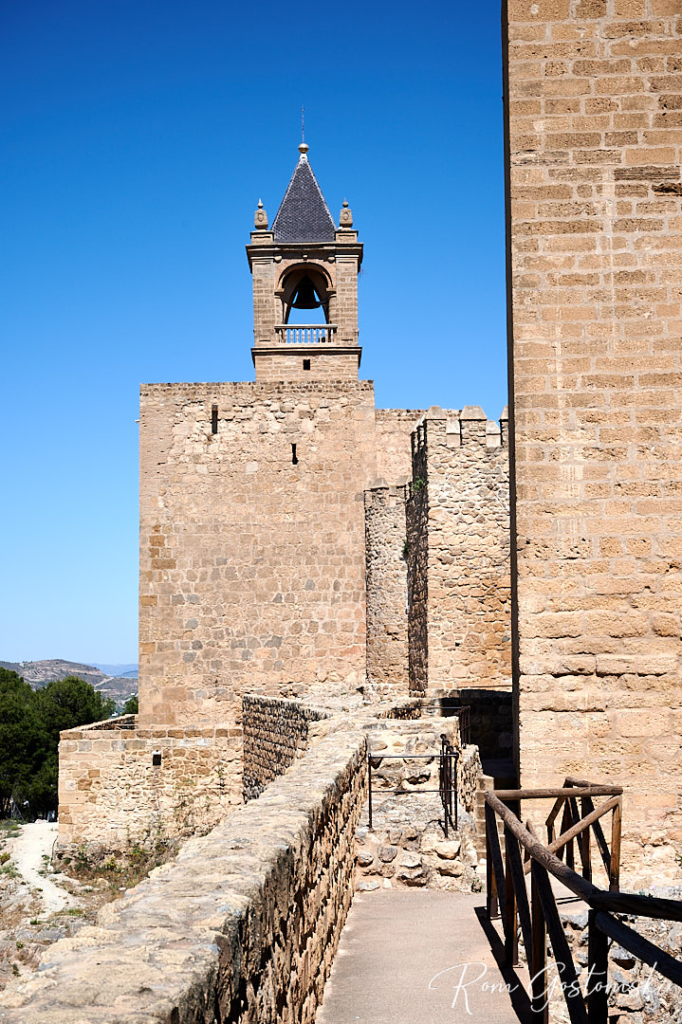
Above: Torre del Homenaje, Alcazaba, Antequera, España
The White Tower, connected to the previous one by a section of walls reinforced by two buttresses, surprises the visitor with the perfect execution of its ashlar masonry.
It has two floors above the height of the battlement and its different rooms are covered with different types of brick vaults.
The interior is illuminated by loopholes and horseshoe arch windows.
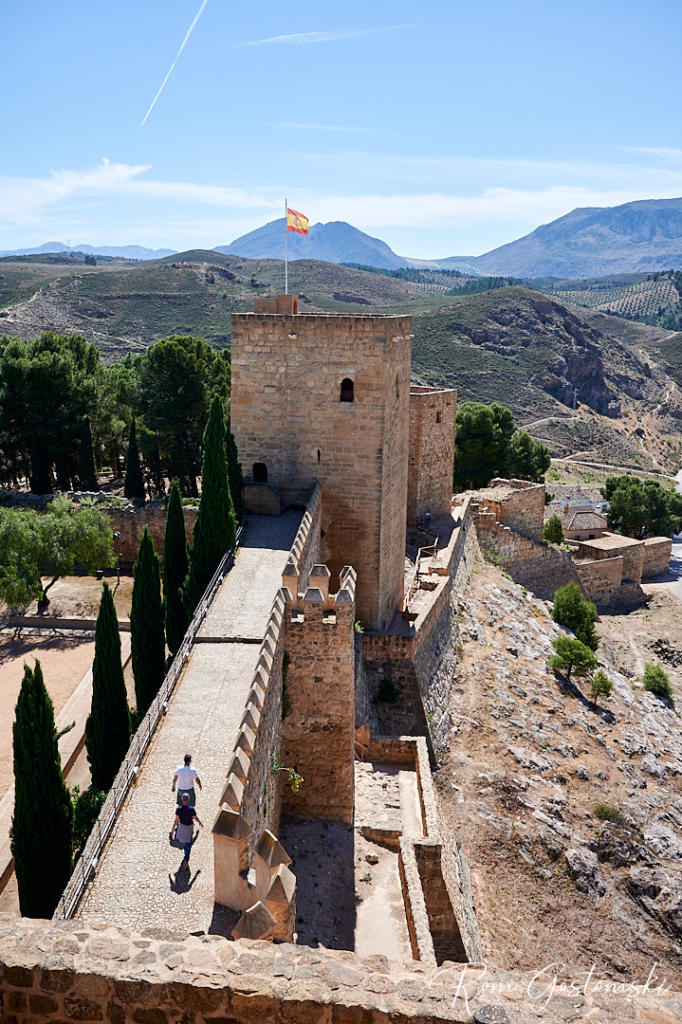
Above: Torre Bianco, Alcazaba, Antequera, España
It is located within the Medina Ring, built in the 14th century to provide shelter to the Muslims expelled by the Castilian conquest.
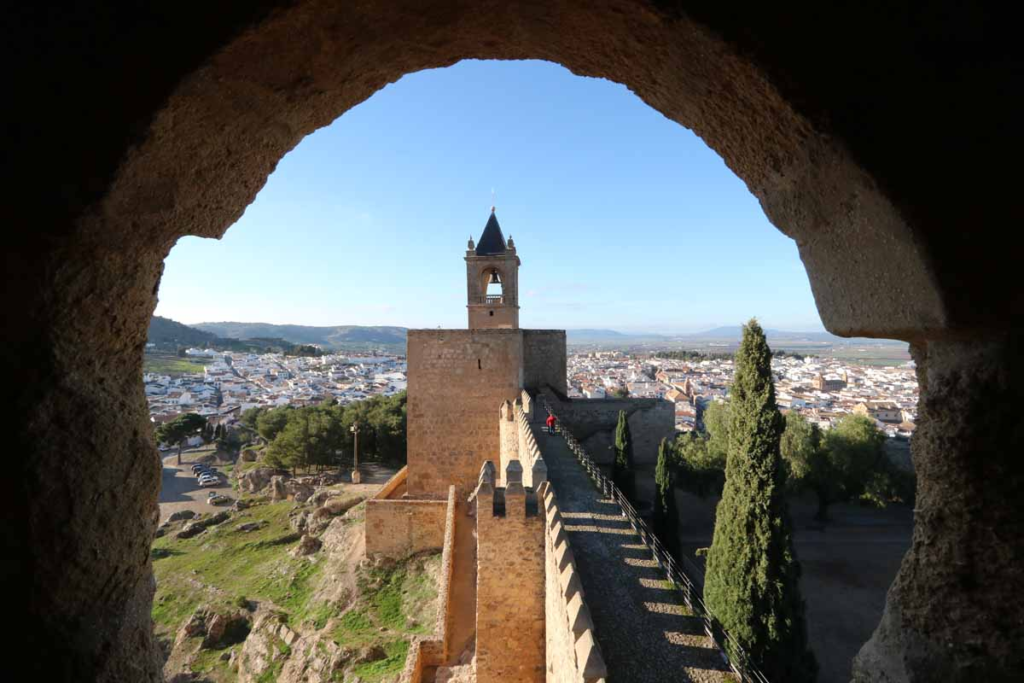
Of the rest of the walled enclosure, the postern and the Estrella watchtower are still preserved, together with the sections of wall recovered from the Plaza del Carmen, and the Water Gate, a small gate next to another watchtower.

The Crooked Tower, now freed of the buildings that hid it, was also a cylindrical watchtower that lacks the arch connecting it to the wall.

In July 2019, the Alcazaba was the location for several scenes from the series Warrior Nun, released on Netflix a year later.

“I am what you might call a practising atheist.
I am quite happy to be an atheist because I actually think God likes atheists better.

Above: Irish comedian Dave Allen (1936 – 2005)
We never ask Him for anything.
We are not bothering Him all the time:
“God, please.”

Above: An image of God, Julius Schnorr (1860)
As a practising atheist there are certain things I don’t understand.
I travel around the world and no matter where I go somebody called Gideon leaves me a Bible.

Above: American association Gideons International emblem
An Irish book, because it says it all began in the beginning.

Above: Coat of arms of Ireland
There are certain things that when I read the Bible – and I do read the Bible – that I find difficult to understand.

I mean if God has been there forever what was He doing before He got to us?
What was He out there doing?
Was He just sitting around?
“I’m bored today.
What will I do?”
And suddenly from nowhere He decided to create a world.
“I’ll make a world.
That’s what I’ll do.”
Rivers, seas, mountains.
Whoom!

“I want a garden.
I’d like a nice garden.”
Whack!
Garden.

Above: The Garden of Eden, Thomas Cole (1828)
“I hate gardening.”
Garden.
Spit and dust.
Adam.
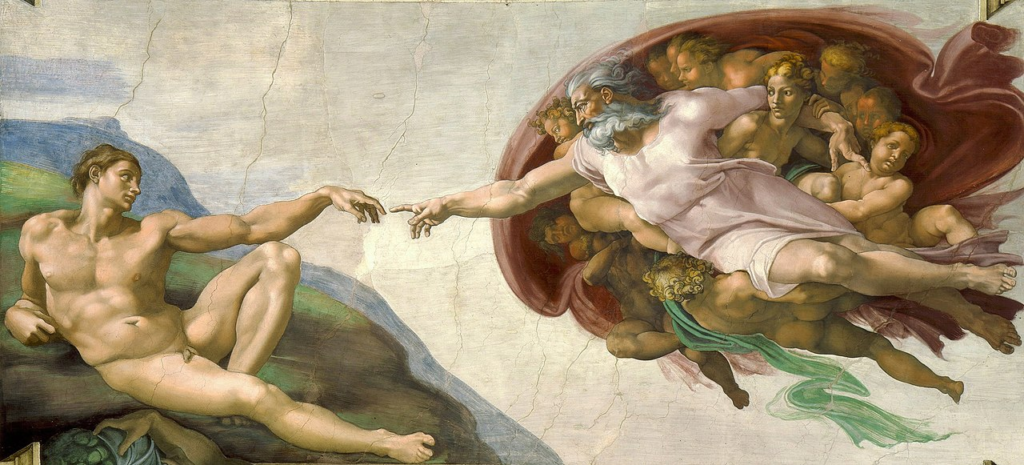
Above: The Creation of Adam, Michelangelo (1512)
And he, Adam, never once says:
“Where in the Name of God do I come from?”
I mean, he is 40 years of age.
He has no child.
He has no recall.
He doesn’t say:
“How did I get here?”
But he is quite happy.
He just travels around the Garden working away.
And God is looking at him and He sees that Adam is happy.
“I didn’t put him there to be happy.
I’ll put a stop to that.”

Above: Adam, Lucas Cranach the Elder (1533)
And God, during the night, sneaks down like a thief and steals, doesn’t ask, doesn’t request, steals, his rib.
And from his rib he makes Woman.
And Adam wakes up in the morning – he is a real thickie.
He is lying there and there is somebody else.
He doesn’t say:
“Where did you come from?
How in Hell did you get here?
Where did you get those lumps?”

Above: Eve, Pantaleon Szyndler (1889)
He just goes out and goes gardening.
And God comes down and has a conversation with Eve.
He tells her that she can eat of any fruit on any tree in the whole Garden with the exception of one fruit tree.
He is talking to a woman.
He actually tells her not to eat of the fruit.
When she says, “Which tree do you mean?“, he actually points it out to her.
And she sneaks up to the tree.
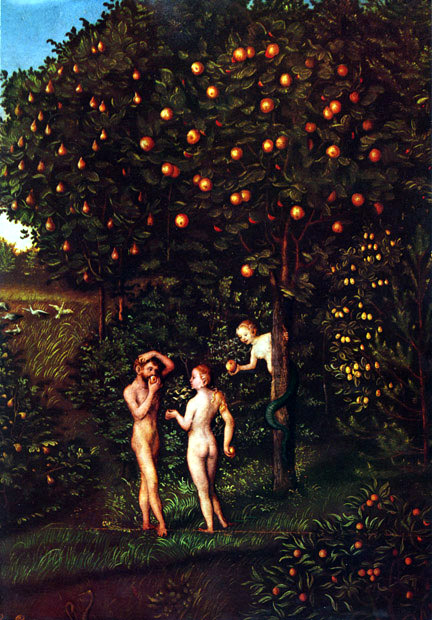
Above: Adam and Eve – Paradise, Lucas Cranach the Elder (1530) – The Tree of Knowledge of Good and Evil is on the right.
A snake comes down and has a conversation with her.
A snake.
Now if I see a snake, I’ll back off.
If one starts talking, I’ll crap myself.
And the snake actually convinces her to eat the apple.

Above: Crowley (as snake), Good Omens
She eats the apple and she learns shame.
That’s what happens when you eat apples.
She is not ashamed that she has disobeyed God, that she has eaten the apple.

She is ashamed of one part of her body.
That’s all.
She becomes ashamed of that area of the body.
Why that area?

Above: The Birth of Venus, Sandro Botticelli (1486)
Why not her elbow?

Her nose?
You actually realize that if Eve had been ashamed of her nose every woman in the world would be sitting here tonight with little nose knickers on.
Men would be in nightclubs watching totally naked ladies with g-strings on their noses.
“Take ’em off.
Oh, I saw a nose!”

And this is the book that you go into court, place your hand upon and swear to tell the truth, the whole truth.“

Inside the Church that stands beneath the Alcazaba there is a sense of abandonment, that God has somehow sought sanctuary somewhere else, that the Holy House has been robbed.
An odd sight within a church….

Declared a National Monument, the Royal Collegiate Church of Santa María La Mayor is a work of transition between
late Gothic and Renaissance.
It was founded on the initiative of Bishop Diego Ramírez de Villaescusa, then in charge of the Diocese of Málaga, who, considering the large population that the city had reached, obtained from Pope Julius II in 1503 the appropriate Bull (a Papal decree) to erect the old Church of Santa María de la Esperanza as a Collegiate Church.
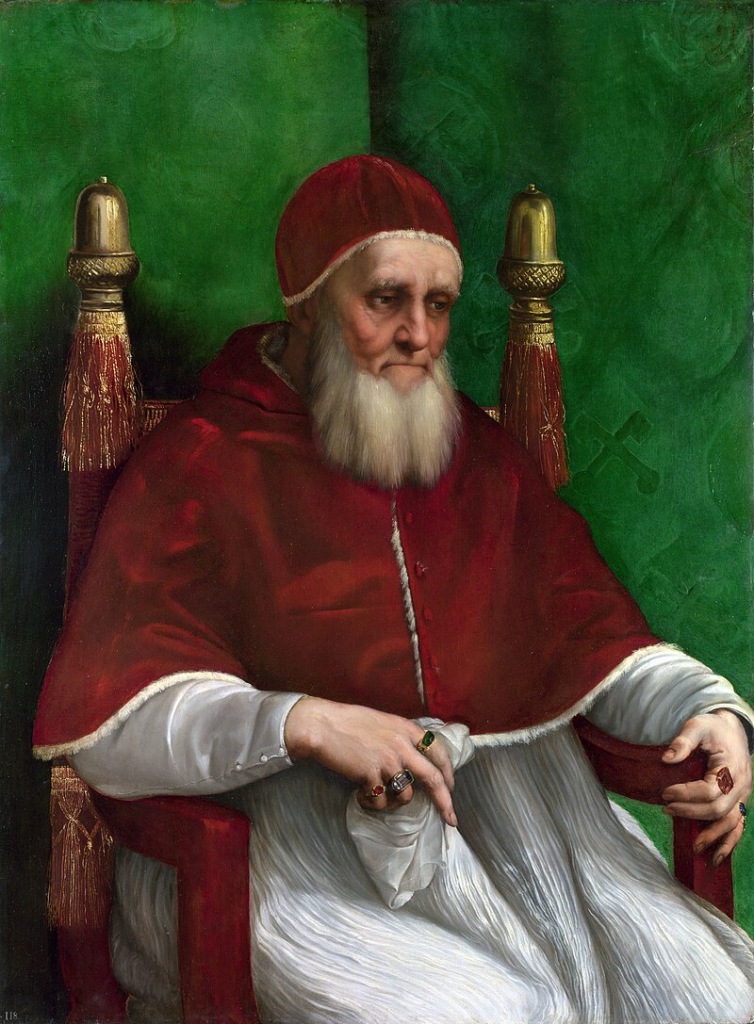
Above: Pope Julius II (né Giuliano della Rovere)(1443 – 1513)
Eleven years later, the same Bishop ordered the construction of a new collegiate factory, which he called Santa María la Mayor.

Above: Spanish Bishop Diego Ramirez de Arellano / Fuenleal / Haro / Villaescusa (1459 – 1537)
It was built between 1514 and 1550.
The work of the architect Pedro del Campo, it is considered the first columnar church built in Andalusia at a time when the taste for Gothic was still in vogue in Spain
It has the honour of being the first temple conceived in the Renaissance style in Andalusia.
It is undoubtedly the most important Renaissance building in the city.
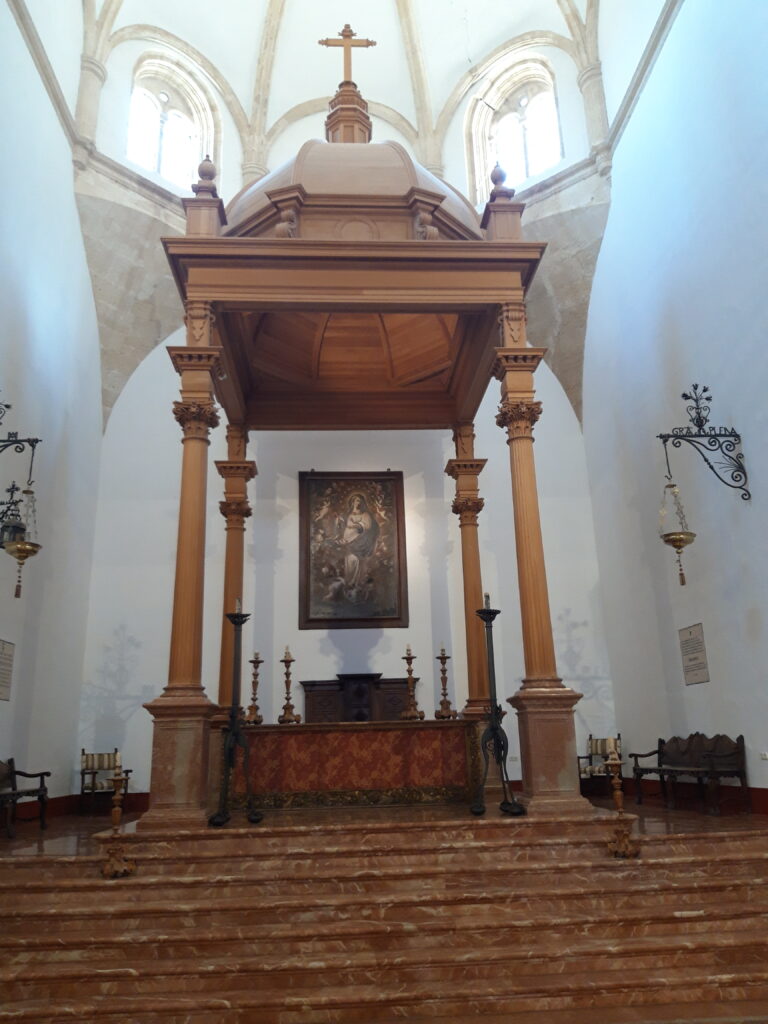
A black basalt block upon which a Marian monument seems surrounded by serpents.
The sign in front of this oddity belies my first impression:
“The Tarasca:
Half serpent, half lady.
The Corpus Christi procession, a very deep religious feast, had a complex scenery in the Baroque period.
This scenery included secular elements such as the “Tarasca“, the most expected one among kids and adults, which was a dreadful monster leading the procession.
It changed its appearance, adopting the shape of a snake or an awful dragon.
Sometimes, it could be ridden by a woman, who usually represented Faith.
This explained the power of Christ over Sin, represented by the Serpent.
During this period, the “Tarasca” was not only a mere ludic element, but it also fulfilled the meaning of the message shown in the symbolic decoration set all along the route of the procession, whose main duty was to venerate the Holy Sacrament.
Today, there are some cities that keep its presence in the procession.
For this occasion, Manuel Jesus Chiapi Gazquez and Chapitel Convercion y Restoracion have recreated the “Tarasca” that was part of the Granada procession in 1760.
It is a dragon with seven heads – that symbolizes the Seven Deadly Sins (pride, greed, wrath, envy, lust, gluttony and sloth) – governed and dominated by Faith, which is set on a castle, as it becomes impregnable and imposes itself on the beast.”
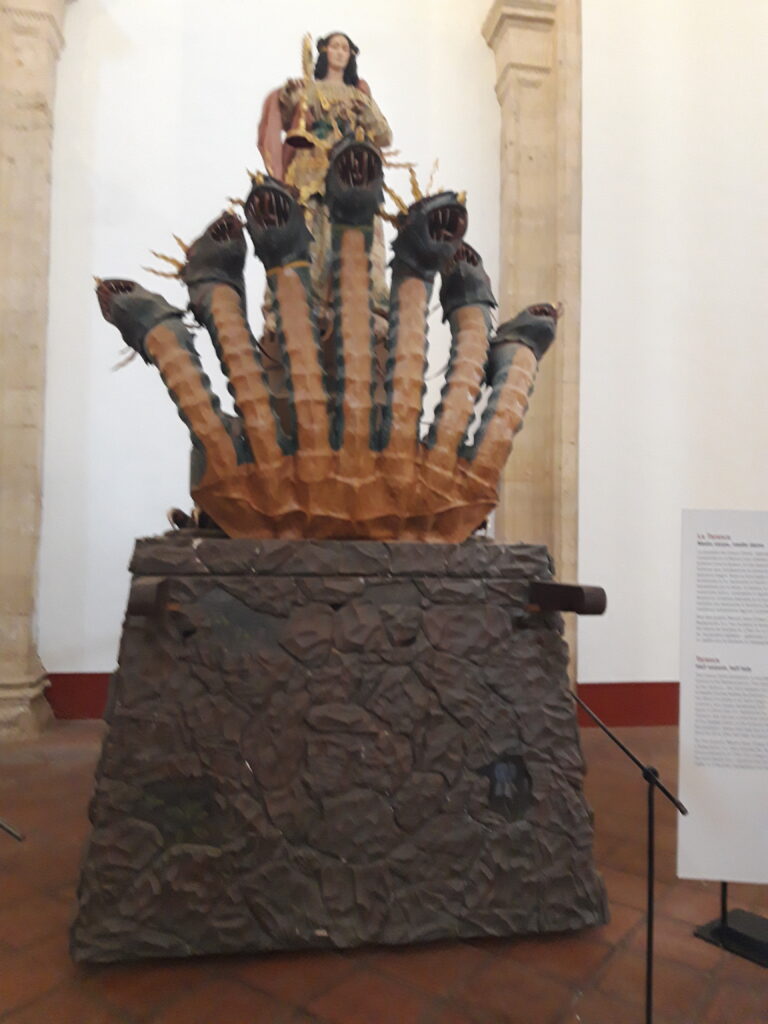
I wonder if there is a connection between the Tarasca and the Tarasque.
The Tarasque is a creature from French mythology.
According to the Golden Legend, the beast had a lion-like head, a body protected by turtle-like carapaces, six feet with bear-like claws, a serpent’s tail, and could expel a poisonous breath.

The Golden Legend (Latin: Legenda aurea or Legenda sanctorum) is a collection of 153 hagiographies by Jacobus de Voragine (1230 – 1298) that was widely read in Europe during the Late Middle Ages.

Above: Italian Archbishop Jacobus de Voragine (1230 – 1298) with the Golden Legend in his hand
More than a thousand manuscripts of the text have survived.
It was probably compiled around 1259 to 1266, although the text was added to over the centuries.
Initially entitled Legenda sanctorum (Readings of the Saints), it gained its popularity under the title by which it is best known.
It overtook and eclipsed earlier compilations of abridged legendaria, the Abbreviatio in gestis et miraculis sanctorum attributed to the Dominican chronicler Jean de Mailly (mid 13th century) and the Epilogus in gestis sanctorum of the Dominican preacher Bartholomew of Trent (1200 – 1251).
When printing was invented in the 1450s, editions appeared quickly, not only in Latin, but also in almost every major European language.
Among incunabula, printed before 1501, Legenda aurea was printed in more editions than the Bible.
It was one of the most widely published books of the Middle Ages.
During the height of its popularity the book was so well known that the term “Golden Legend” was sometimes used generally to refer to any collection of stories about the Saints.

It was one of the first books William Caxton printed in the English language.
Caxton’s version appeared in 1483.
His translation was reprinted, reaching a 9th edition in 1527.

Above: English printer William Caxton (1422 – 1491)
Written in simple, readable Latin, the book was read in its day for its stories.
Each chapter is about a different Saint or Christian festival.
The book is considered the closest thing to an encyclopaedia of medieval saint lore that survives today.
As such, it is invaluable to art historians and medievalists who seek to identify Saints depicted in art by their deeds and attributes.
Its repetitious nature is explained if Jacobus meant to write a compendium of saintly lore for sermons and preaching, not a work of popular entertainment.)
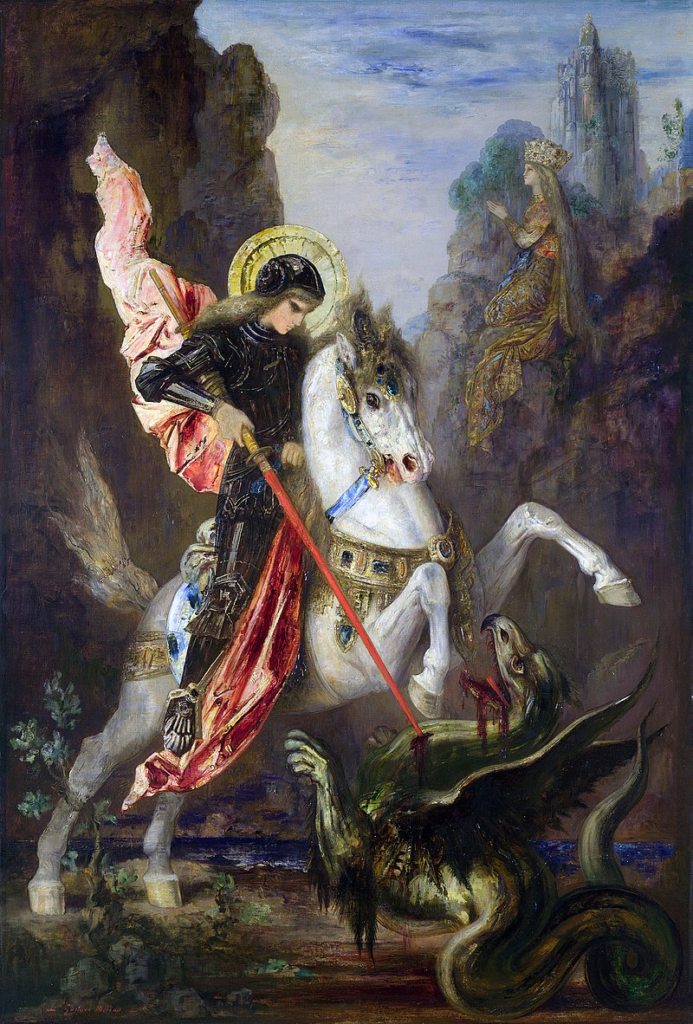
Above: St. George and the Dragon
Medieval iconography, such as renditions in Church sculpture, did not necessarily conform to this description in the earlier Gothic period.
Examples, which seemed to conform, were later assigned to 14th century dates.
The six-footed, turtle-shelled tarasque was the form depicted on the city seal of Tarascon around the 15th century.
This was held to be the norm in 16th and 17th century paintings.
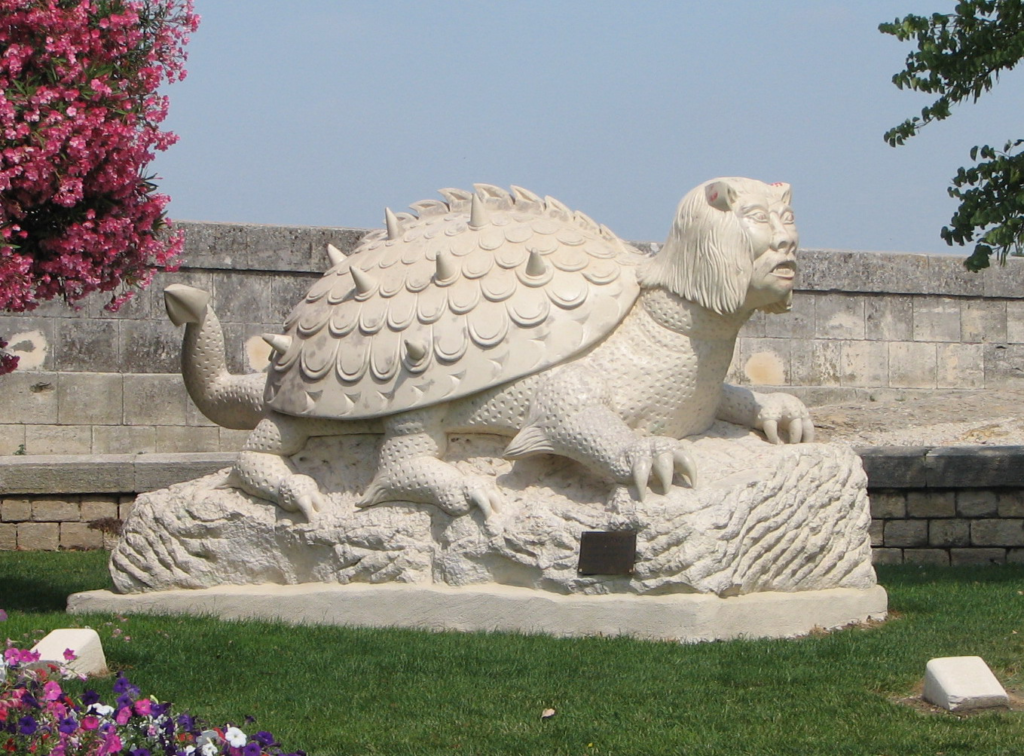
As St. Martha purportedly encountered the beast in the act of swallowing a human victim, it has become a stock motif in art to portray the monster swallowing a human head first, with the victim’s legs still dangling.
Above: St. Martha and the Tarasque, Jacques de Voragine
According to tradition, in 1474 René of Anjou initiated the use of the tarasque in the Pentecostal festival.
It was later used also on the Saint’s feast day of 29 July.
Yearly celebration in the last weekend of June was added in the modern day.

Above: René d’Anjou, King of Naples (1409 – 1480)
The effigy or float (French: char) of the tarasque has been built over the years for parading through town for the occasion, carried by four to a dozen men concealed inside.

The Tarasque was designated one of “Processional Giants and Dragons in Belgium and France” listed in November 2005 as part of UNESCO’s Masterpieces of the Oral and Intangible Heritage of Humanity.

Above: Logo of the United Nations Educational, Scientific and Cultural Organization
The exterior of this place of worship is far more beautiful, less confusing than its interior.
A feminine functional figure of Faith inside a structure of solid constancy and beauty – such is the Collegiate Church of Santa María La Mayor.
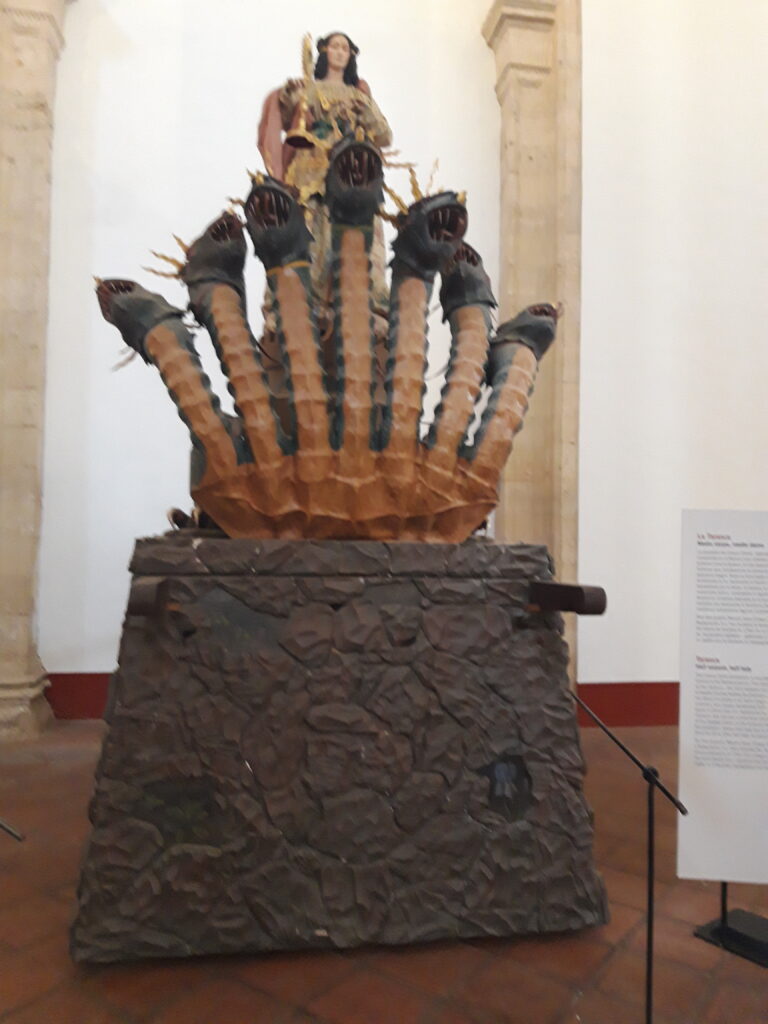
I think of the story of the Garden of Eden and the snake that tempted Eve to eat the apple.
I juxtapose this thought with thoughts of the Tarasca, though explained as being a woman riding a snake, it is entitled “The Tarasca: Half Woman, Half Serpent“.
Where is Dan Brown’s Professor of Iconology and Symbology Robert Langdon when we need him?
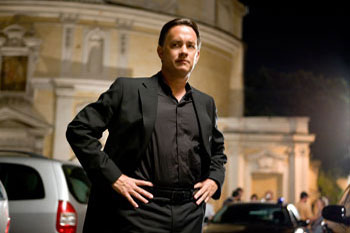
Above: Robert Landon (Tom Hanks), Angels and Demons
There is something almost tangible in the skein of speculation navigating the labyrinth of my mind.
Leonard Cohen croons from his “Bird on the Wire” song:
I saw a beggar leaning on his wooden crutch
He said to me, “You must not ask for so much“
And a pretty woman leaning in her darkened door
She cried to me, “Hey, why not ask for more?“

Above: Canadian musician-poet Leonard Cohen (1934 – 2016)
I recall Dave Allen’s joke:
Adam just works away in the Garden happily.
It is Eve who is not content.
It is She who is curious and tempted.
Yet the Biblical story somehow paints her as a victim.
God shows her what she cannot have.
She allows herself to be convinced by another rather than acknowledging that her desire was the true incentive, not the words of a belly-crawling beast.
She is not content suffering solo but recruits Adam to abandon his happiness for her by partaking of the same forbidden fruit.

Above: The Garden of Eden with the Fall of Man, Jan Brueghel the Elder and Pieter Paul Rubens (1615)
From the get-go, Man is a lovable dope, a gullible dupe.
Why did he do this?
Was he like many modern men when faced with their lady love’s anger, complaints or general unhappiness simply becomes a creature who submits, mumbles an apology and tiptoes away?
Was he simply trying to satisfy the woman in his life?

She, who was intended as a helpmate to Adam, ultimately dooms them both.
But it is not her fault, Woman argues.
A situation was created.
She only reacted to it.
Poor thing.
God made the Tree.
The serpent seduced her.
Suddenly, they hear:
“Out, out, everyone out of the pool.“

Above: Expulsion from Paradise, James Tissot (1902)
I think of Don Quixote and how he could not be a knight-errant without a lady love.
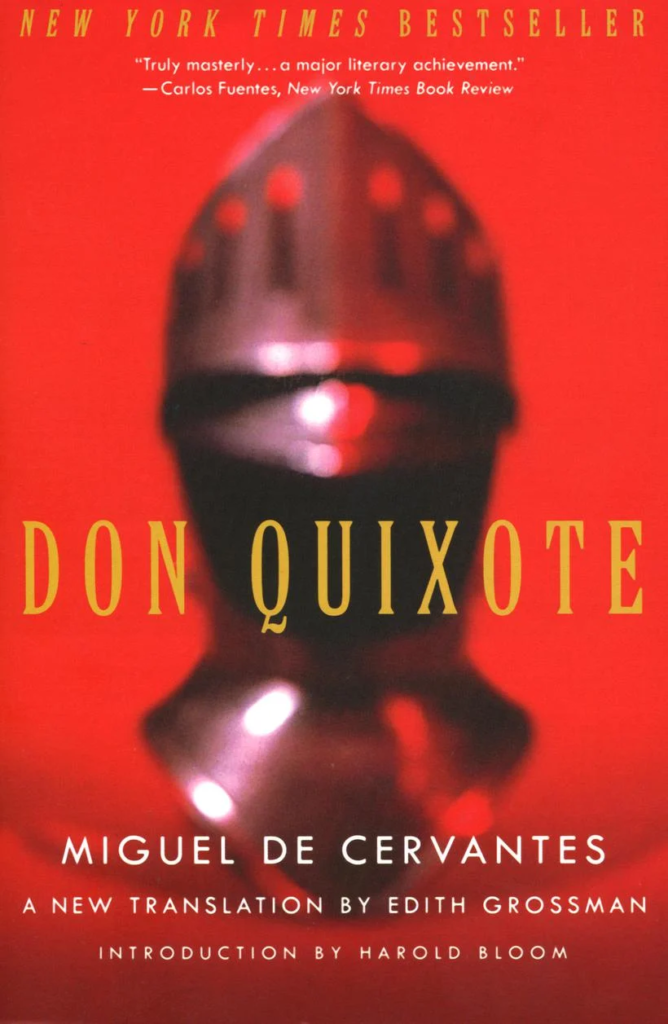
“The genius of the Spanish people is exquisitely subtle, without being at all acute.
Hence there is so much humour and so little wit in their literature.“
Samuel Taylor Coleridge

Above: English poet Samuel Taylor Coleridge (1772 – 1834)
But by placing a woman high upon a black basalt block, placing her atop some elevated pedestal – my major grievance with Catholicism in particular and Christianity in general – we do not as men do ourselves any favours.
Women are only human.
Sometimes they are completely right (as men can be) and completely wrong (as men often are).
A woman is neither a devil nor a saint.
(Perhaps she is half woman, half serpent?)
Women are normal fallible beings who have somehow fooled themselves into thinking of themselves as entitled entities rather than the equal of men.
Women can be (and often are) wrong, immature, perverse, prejudiced, competitive and as bloody-minded as men.
Where we seem to differ is in our perceptions.

Sigmund Freud has suggested that women envy men and, up to a point, there is some validity to this.
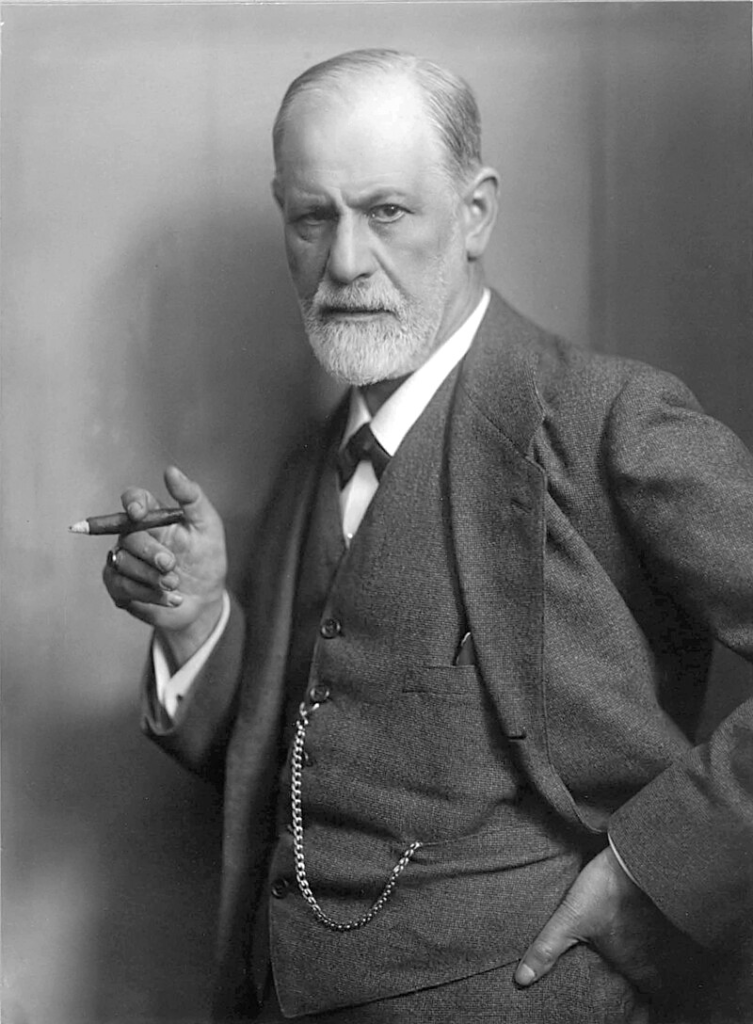
Above: Austrian Dr. Sigmund Freud (1856 – 1939)
Men are physically stronger so we do not worry about our vulnerability as much, though 90% of convicted acts of violence are carried out by men, with 67% of the victims men themselves.
The role of protector is foisted on men up to and including the level of military service.
One of the most important rules is that a man must, under all circumstances, protect a woman from all unpleasantness – even if that unpleasantness is a reaction of anger for the wrong that she may do against the man.
A man must suppress his emotions while a woman is rarely held accountable for her actions when she expresses hers.

Men need not worry about becoming pregnant, though modern men are concerned about fathering children.
Children are endearing, but this in itself is not a reason for producing them.
There are some men who would argue that when a man engenders children, he gives a woman hostages in the hopes that she will exploit him forever.
Thanks to wife and child, man acquires an excuse, an artificial justification for his wretched existence and subjection – that Holy unit of Family.
He tells himself that Family gives his life meaning.
Certainly, there is a certain degree of unpleasantness in pregnancy, childbirth and child care, but in exchange She gets lifelong security, and comfort.

For hundreds of thousands of years the human race lived in small nomadic groups.
In the highly stable lifestyle of the tribe and the village, fathers and their children lived and worked in close proximity.
The elders taught their children their own trade and, at the same time, how to be an adult.
It was a long apprenticeship.
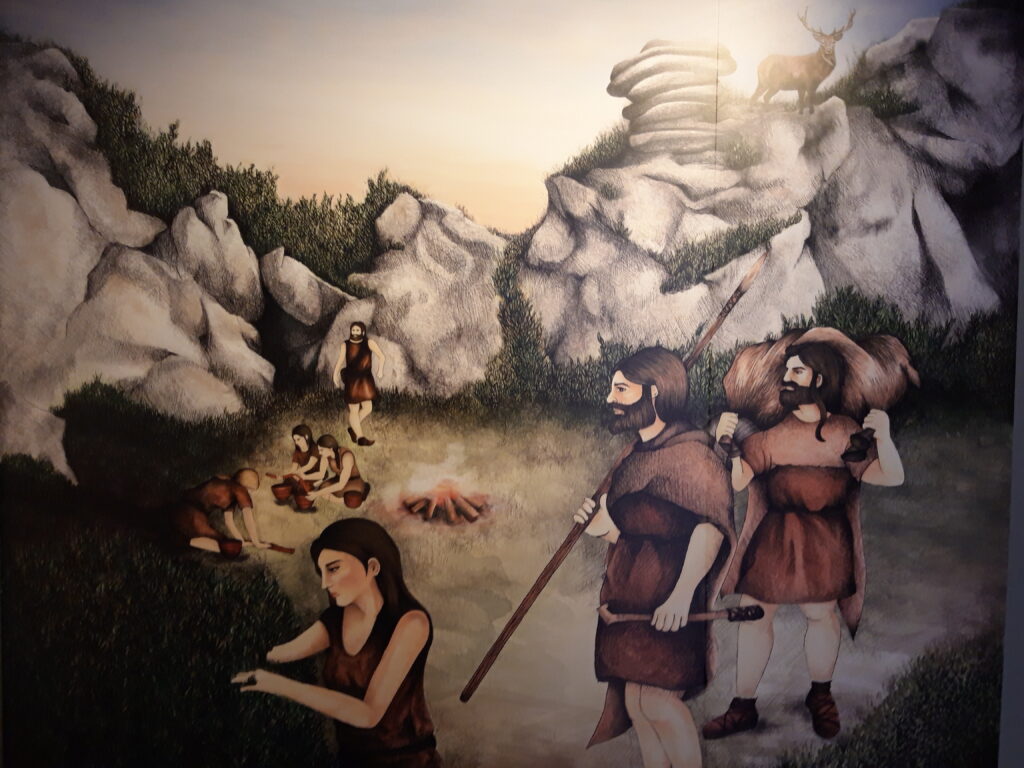
All day, every day, children were surrounded by adults, actively and enjoyably encouraging and teaching them.
They drank in deeply the tone, style and manner of being a grown-up, from dozens of role models, who were tough and tender with them as needed.
Life in hunter-gathering times was (surprisingly) more comfortable, more leisurely than modern times.
Most people could meet their food and shelter needs with only a couple of hours work per day.
The detailed knowledge and consummate skill of the people accumulated over aeons and systematically handed down, one-to-one, to each child, meant that Life was abundant and pleasurable.

Not all was perfect, of course.
Ancient cultures had their problems too, but they had a balance and life-preserving quality that had been honed for generations.
Then in the blink of an eye, it all began to change.
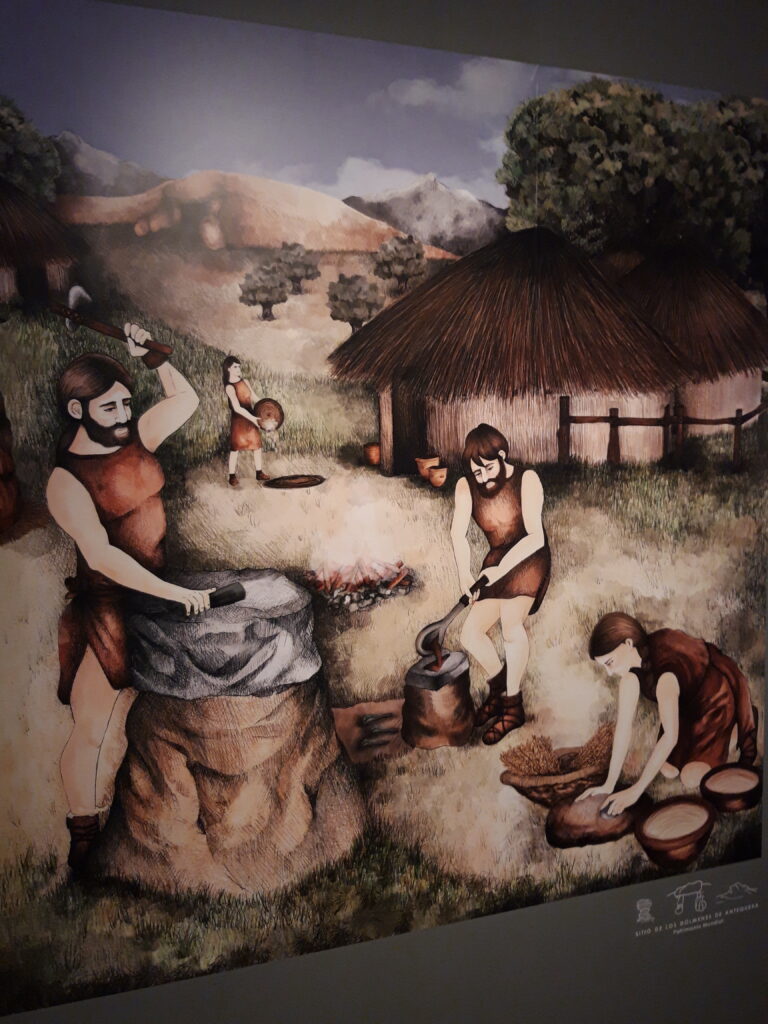
The shift to agriculture, the birth of cities and the Industrial Revolution arrived and changed everything forever.
Villagers were evicted to free up the land for wool, which was more profitable than crops.
Wool needed a fraction of the labour force to tend.

The towns needed a workforce – factory works, clerks, miners and labourers.
It was a matter of change or starve.
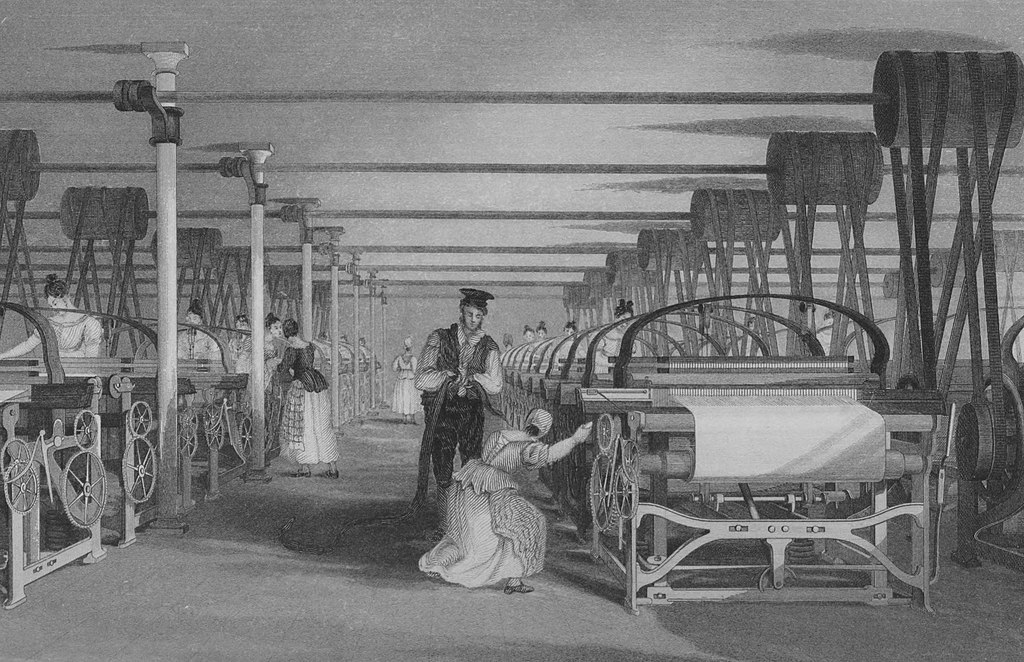
Fathers worked away from their families, waking before first light and returning after dark.
Schooling was introduced – not so much for humanitarian reasons but because it was found to prepare children better to be placid factory workers.
For the first time in human history a generation grew up without fathers in the true sense.

Today we take this arrangement for granted.
Fathers work.
Mothers raise children (or put them in childcare for other women to raise them).
Daddy goes to work, where he simply disappears into a void of incomprehensible activity, for most of the day and week and childhood.
As a result, men have few skills in interpersonal relationships, for their fathers and later themselves are not at home to develop these skills.

With our high level of marriage breakdown – at least 40% of marriages break down with divorces initiated by the woman in 70% of the cases – perhaps one third of all children grow up with an absent or intermittent father in their family life.
After one year following divorce, over 30% of fathers had no further contact with their children!
If the father in a family inhabits the home for only an hour or two (or less) in the evenings, then women’s values, marvellous as they might be, will often only become the only values in the home.
What children get from a career father is not his happiness nor his teaching nor his substance but only his mood, which after a hard day of work is mostly irritation and fatigue.
To have a demanding job, commute to work in the city and raise children is, well, an impossibility.
Something’s gotta give.

An absentee parent, someone you deeply need, produces a great intensity of feeling.
Men show their love by working hard and long.
And they do not get appreciated for it – since it is their physical presence, not their bounty, that is hungered for in the home.

My child arrived just the other day.
He came to the world in the usual way.
But there were planes to catch and bills to pay.
He learned to walk while I was away.
And he was talking ‘fore I knew it, and as he grew
He’d say “I’m gonna be like you, Dad.”
“You know I’m gonna be like you.”
And the cat’s in the cradle and the silver spoon
Little Boy Blue and the Man in the Moon
“When you coming home, Dad?” “I don’t know when.
But we’ll get together then.
You know we’ll have a good time then.“

My son turned ten just the other day
He said, “Thanks for the ball, Dad, come on, let’s play.
Can you teach me to throw?” I said, “Not today.
I got a lot to do.” He said, “That’s okay.“
And he walked away, but his smile never dimmed
It said, “I’m gonna be like him, yeah
You know I’m gonna be like him.“
And the cat’s in the cradle and the silver spoon
Little Boy Blue and the Man in the Moon
“When you coming home, Dad?” “I don’t know when.
But we’ll get together then.
You know we’ll have a good time then.”

Well, he came from college just the other day
So much like a man I just had to say
“Son, I’m proud of you. Can you sit for a while?“
He shook his head and said with a smile
“What I’d really like, Dad, is to borrow the car keys.
See you later. Can I have them, please?“
And the cat’s in the cradle and the silver spoon
Little Boy Blue and the Man in the Moon
“When you coming home, son?” “I don’t know when.
But we’ll get together then, Dad.
You know we’ll have a good time then.“
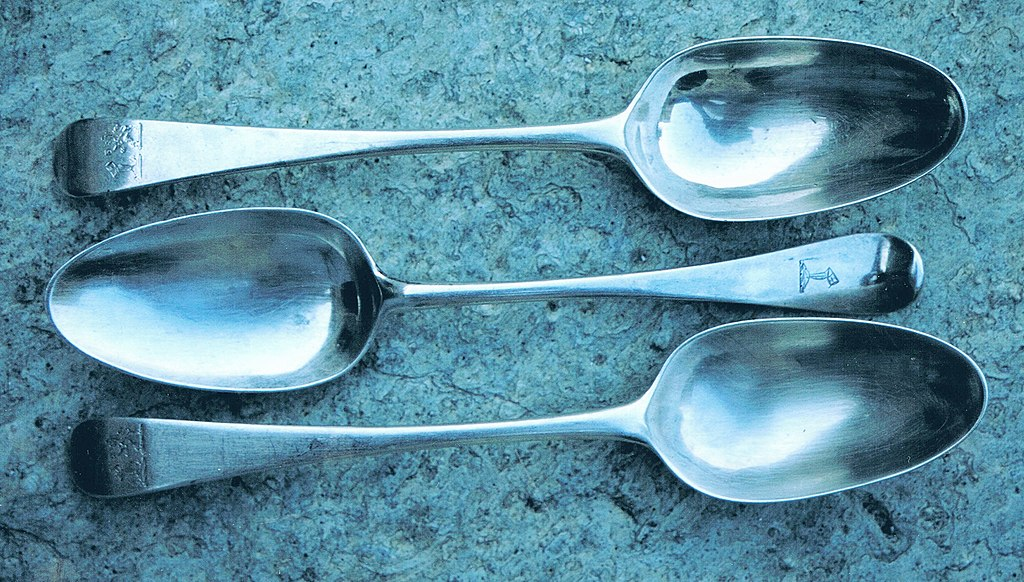
I’ve long since retired. My son’s moved away.
I called him up just the other day.
I said, “I’d like to see you if you don’t mind.“
He said, “I’d love to, Dad, if I can find the time.
You see, my new job’s a hassle, and the kids have the flu.
But it’s sure nice talking to you, Dad.
It’s been sure nice talking to you.“
And as I hung up the phone, it occurred to me
He’d grown up just like me.
My boy was just like me.
And the cat’s in the cradle and the silver spoon
Little Boy Blue and the Man in the Moon
“When you coming home, son?” “I don’t know when.
But we’ll get together then, Dad.
We’re gonna have a good time then.“

The modern woman saddens me.
She tells men that she will not marry a poor man but rather he must approach her with a substantial income.
But substantial wealth, unless a man was born into a wealthy family, demands substantial time and effort from a man.
Many women expect their male partners to maintain that lifestyle that attracted her.
That lifestyle creates lonely men in loveless marriages and sad families.
Men cannot improve their sociability if removed from the family unit that teaches this.

Girls and women fear physical violence and sexual assault, but rarely do we imagine that the opposite gender has causes for concern as well.
One in seven boys will experience sexual assault by an adult or an older child before the age of 18.

Men are not overly concerned with their appearance since much of human society is looking at her more than at him.
Men are not aware of their own beauty because no one dares mentions it.
Most men are beautiful.
Smooth bodies, kept trim by hard work, with strong shoulders, muscular legs, melodic voices, warm laughter, intelligent expressive faces and calibrated meaningful movements.
Not only do men overshadow women in a purely animal sense but men retain our beauty longer because most men work.
Women’s bodies rapidly decay into indifferent heaps of human cells.
Compare an active 50-year-old man with an inert 50-year-old woman.
Who truly is the more beautiful?

But we are never praised for our appearance, for that sort of praise is considered unmanly and borderline homosexual.
Instead we are praised for our steadfastness, courage and reliability – all qualities that have nothing to do with physical appearance.
Does society hold beautiful women up to the same qualities?
Do women see men as desirable delights or are we merely unusual machines in their service?
Who regards a machine as an object of beauty?
Who would ever dream of going into great detail about the exact shape of his lips or the precise shade of his eyes in a special kind of light?
Just imagine the average man’s amazement and amusement if the delicacy of his nipples or the pleasing shape of his genitalia were ever discussed!!!
How beautiful can a woman truly be if make-up is needed to maintain the illusion?
Perhaps man thinks woman is beautiful because she thinks she is beautiful.
Perhaps man does not think of himself as beautiful, because no one ever associates “beauty” with this beast.

And yet we voluntarily submit ourselves to women in the dim hopes that we can win and keep their love and loyalty.
That without women there is no motivation for men to succeed.
If we treat woman as superior beings, they will gladly adapt that role.
How many men must wonder whether men are merely the footlights for women?

Above: Supermodel Gisele Bundchen
“It is a truth universally acknowledged, that a single man in possession of a good fortune, must be in want of a wife.
However little known the feelings or views of such a man may be on his first entering a neighbourhood, this truth is so well fixed in the minds of the surrounding families, that he is considered the rightful property of some one or other of their daughters.“
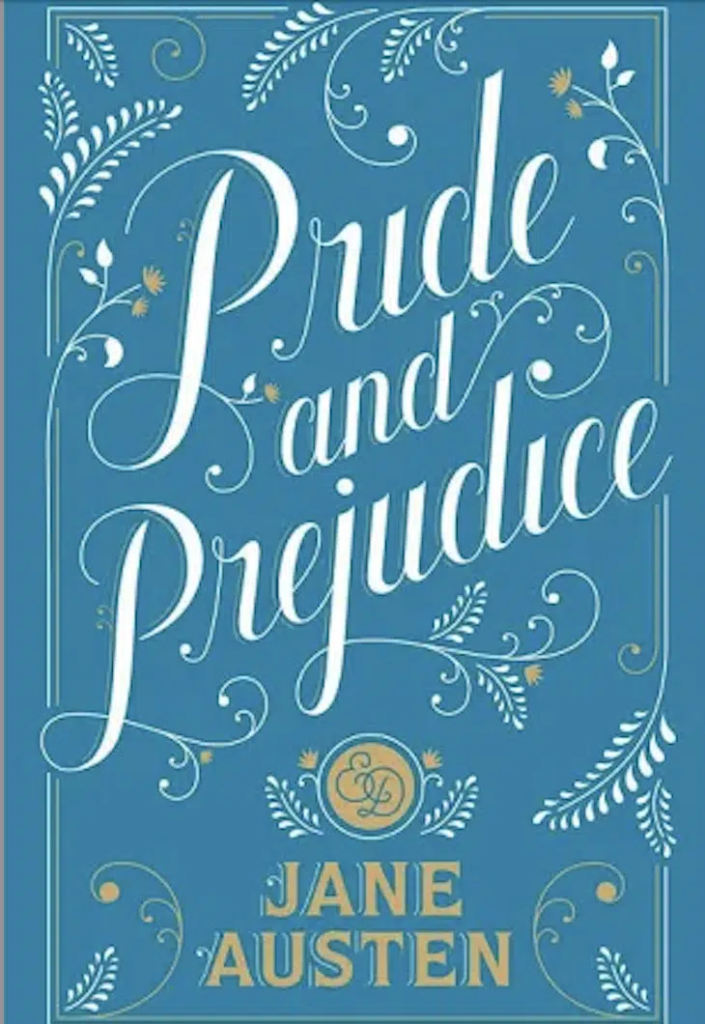
I am neither anti-female nor anti-feminist.
Feminism is about women liberating themselves – changing perceptions and laws and employment practices.
It is both necessary and wonderful.
Feminism has been the biggest movement in human history.
Women across all cultures and religions have suffered immeasurably for thousands of years.
Feminism asks men to change.
But the unasked question is:
How can men change if women continue to put men in situations from which they cannot escape?

Above: Flag of feminism
You cannot liberate only half the human race.
Women cannot expect equality if they continue to treat men unequally.
Women cannot expect men to change if they will not change their own behaviour as a model for men to adapt to.

In this power struggle between the sexes, men have never been winning, regardless of the propaganda that suggests otherwise.

“Love and war are the same thing, stratagems and policy are as allowable in the one as in the other.“

Women live longer than men.
Men routinely fail at close relationships.
Over 90% of convicted acts of violence are carried out by men.
Around 90% of children with behaviourial problems are boys.
Over 80% of children with learning problems are boys.
Men comprise over 90% of inmates of prisons.
The leading cause of death amongst men between 12 and 60 is self-inflicted.
Over 75% of suicides are male.
Males commit suicide four times more frequently than women.
In the game of Life, most men are not winning.
And many women are too selfish and narcissistic to care that the men whose attention and wealth they seek are even more unfulfilled and more unhappy than they are.

In Greek mythology, Pandora was the first human woman created by Hephaestus on the instructions of Zeus.
As Hesiod related it, each god cooperated by giving her unique gifts.
Her other name — inscribed against her figure on a white-ground kylix in the British Museum — is Anesidora: “she who sends up gifts” (implying “from below” within the Earth).
The Pandora myth is a kind of theodicy, addressing the question of why there is evil in the world, according to which, Pandora opened a jar (commonly referred to as “Pandora’s box“) releasing all the evils of humanity.
It has been argued that Hesiod’s interpretation of Pandora’s story went on to influence both Jewish and Christian theology and so perpetuated her bad reputation into the Renaissance.
Later poets, dramatists, painters and sculptors made her their subject.

Above: Pandora, John William Waterhouse (1896)
The Pandora myth first appeared in lines 560 – 612 of Hesiod’s poem in epic meter, the Theogony (8th – 7th centuries BC), without ever giving the woman a name.
After humans received the stolen gift of fire from Prometheus, an angry Zeus decides to give humanity a punishing gift to compensate for the boon they had been given.
He commands Hephaestus to mold from the earth the first woman, a “beautiful evil” whose descendants would torment the human race.
After Hephaestus does so, Athena dresses her in a silvery gown, an embroidered veil, garlands and an ornate crown of silver.

Above: Allegory of Vanity: Pandora, Nichols Régnier (1626)
This woman goes unnamed in the Theogony, but is presumably Pandora, whose myth Hesiod revisited in Works and Days.
When she first appears before gods and mortals, “wonder seized them” as they looked upon her.
But she was “sheer guile, not to be withstood by men“.
Hesiod elaborates (590 – 593):
For from her is the race of women and female kind:
Of her is the deadly race and tribe of women who live amongst mortal men to their great trouble, no helpmeets in hateful poverty, but only in wealth.“
Hesiod goes on to lament that men who try to avoid the evil of women by avoiding marriage will fare no better (604 – 607):
He reaches deadly old age without anyone to tend his years, and though he at least has no lack of livelihood while he lives, yet, when he is dead, his kinsfolk divide his possessions amongst them.“
Hesiod concedes that occasionally a man finds a good wife, but still “evil contends with good“.
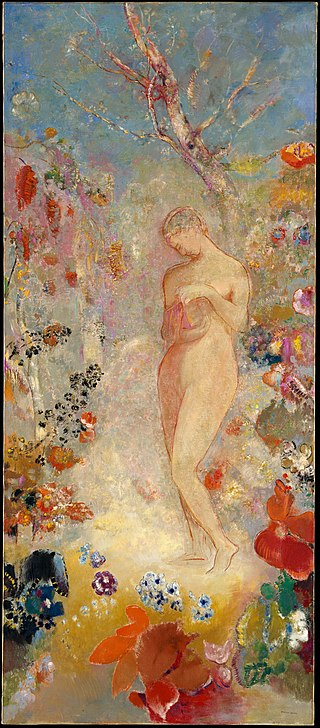
Above: Pandora, Odilon Redon (1914)
The more famous version of the Pandora myth comes from another of Hesiod’s poems, Works and Days.
In this version of the myth (lines 60 – 105), Hesiod expands upon her origin and moreover widens the scope of the misery she inflicts on humanity.
As before, she is created by Hephaestus, but now more gods contribute to her completion (63 – 82):
Athena taught her needlework and weaving (63 –64).
Aphrodite “shed grace upon her head and cruel longing and cares that weary the limbs” (65 – 66).
Hermes gave her “a shameless mind and a deceitful nature” (67 –68).
Hermes also gave her the power of speech, putting in her “lies and crafty words” (77 – 80).
Athena then clothed her (72).
Next, Persuasion and the Charites adorned her with necklaces and other finery (72 – 74).
The Horae adorned her with a garland crown (75).
Finally, Hermes gives this woman a name: “Pandora” [“all-gift“], because all they who dwelt on Olympus gave each a gift, a plague to men who eat bread (81 – 82).
In this retelling of her story, Pandora’s deceitful feminine nature becomes the least of humanity’s worries.
For she brings with her a jar (which, due to textual corruption in the 16th century, came to be called a box) containing “countless plagues” (100).
Prometheus had (fearing further reprisals) warned his brother Epimetheus not to accept any gifts from Zeus.
But Epimetheus did not listen.
He accepted Pandora, who promptly scattered the contents of her jar.
As a result, Hesiod tells us, the earth and sea are “full of evils” (101).
One item, however, did not escape the jar (96 – 99):
Only Hope remained, there in an unbreakable home within, under the rim of the great jar, and did not fly out at the door, for ere that, the lid of the jar stopped her, by the will of Aegis-holding Zeus who gathers the clouds.“
Hesiod does not say why hope (elpis) remained in the jar.
Hesiod closes with a moral (105):
There is “no way to escape the will of Zeus.“

Above: Pandora, Pierre Loison
Hesiod also outlines how the end of man’s Golden Age (an all-male society of immortals who were reverent to the gods, worked hard, and ate from abundant groves of fruit) was brought on by Prometheus.
When Prometheus stole fire from Mt. Olympus and gave it to mortal man, Zeus punished the technologically advanced society by creating a woman.
Thus, Pandora was created and given the jar (mistranslated as ‘box‘) which releases all evils upon man.
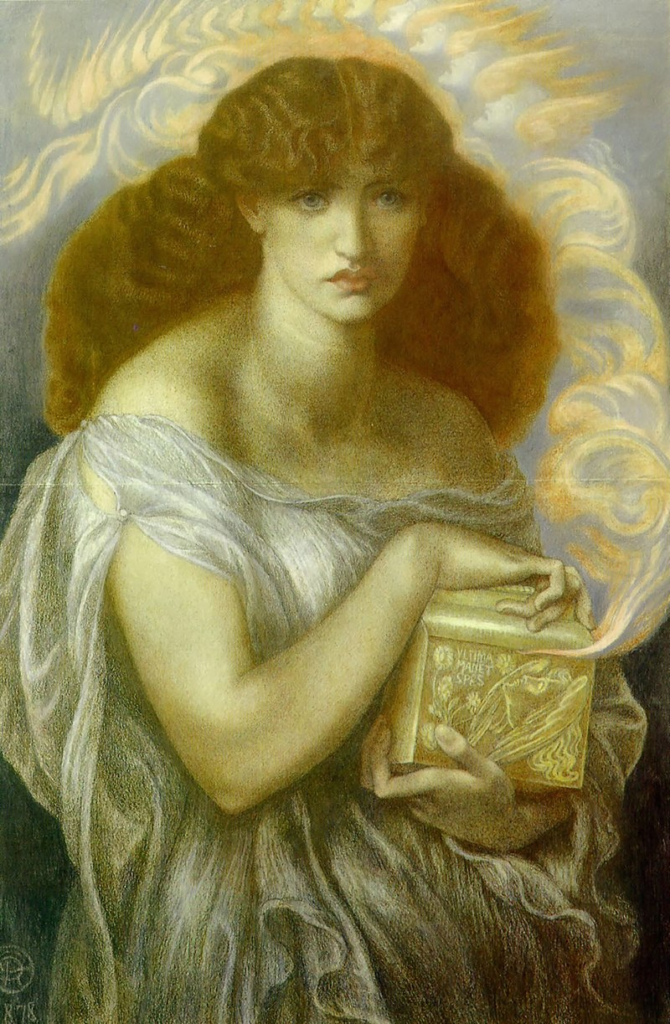
Above: Pandora, Dante Gabriel Rossetti (1879)
Archaic and Classic Greek literature seem to make little further mention of Pandora, but mythographers later filled in minor details or added postscripts to Hesiod’s account.
For example, the Bibliotheca and Hyginus each make explicit what might be latent in the Hesiodic text:
Epimetheus married Pandora.
They each add that the couple had a daughter, Pyrrha, who married Deucalion and survived the deluge with him.
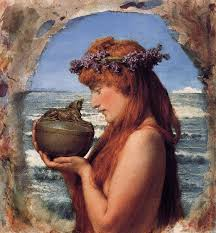
However, the Hesiodic Catalogue of Women, fragment #5, had made a “Pandora” one of the daughters of Deucalion, and the mother of Graecus by Zeus.
In the 15th century an attempt was made to conjoin pagan and scriptural narrative by the monk Annio da Viterbo, who claimed to have found an account by the ancient Chaldean historian Berossus in which “Pandora” was named as a daughter-in-law of Noah in the alternative Flood narrative.
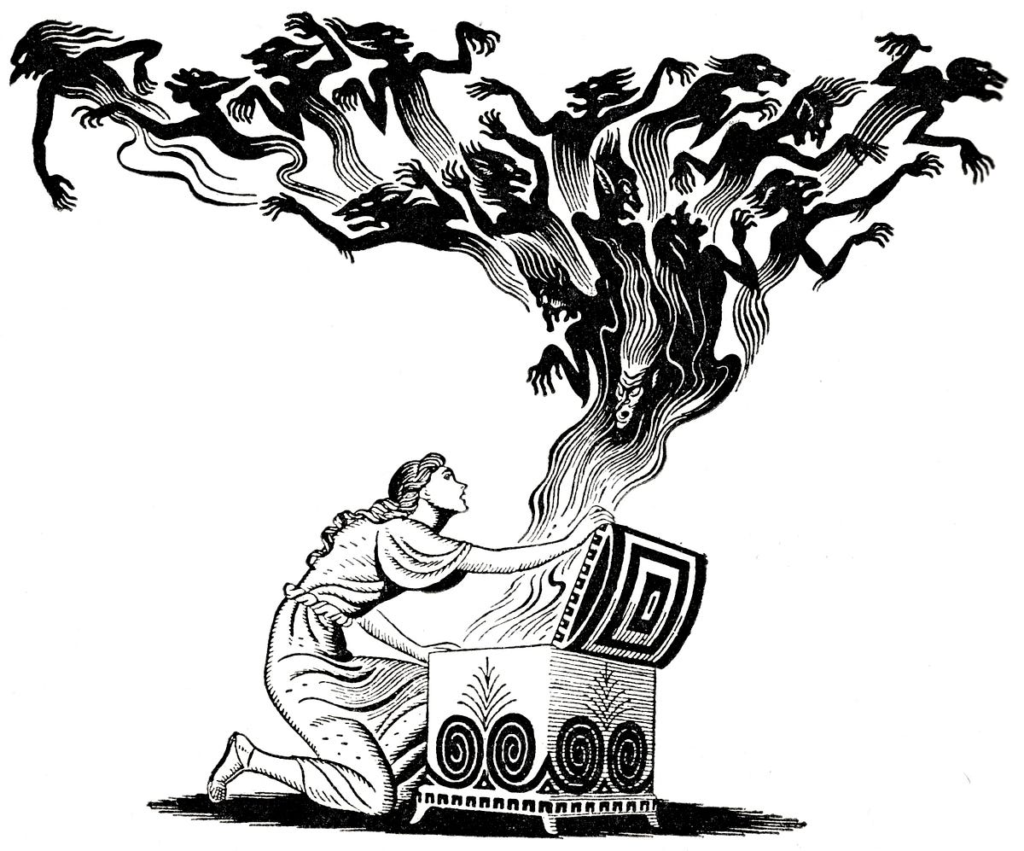
The mistranslation of pithos, a large storage jar, as “box” is usually attributed to the 16th century humanist Erasmus of Rotterdam when he translated Hesiod’s tale of Pandora into Latin.
Hesiod’s pithos refers to a large storage jar, often half-buried in the ground, used for wine, oil or grain.
It can also refer to a funerary jar.
Erasmus, however, translated pithos into the Latin word pyxis, meaning “box“.
The phrase “Pandora’s box” has endured ever since.
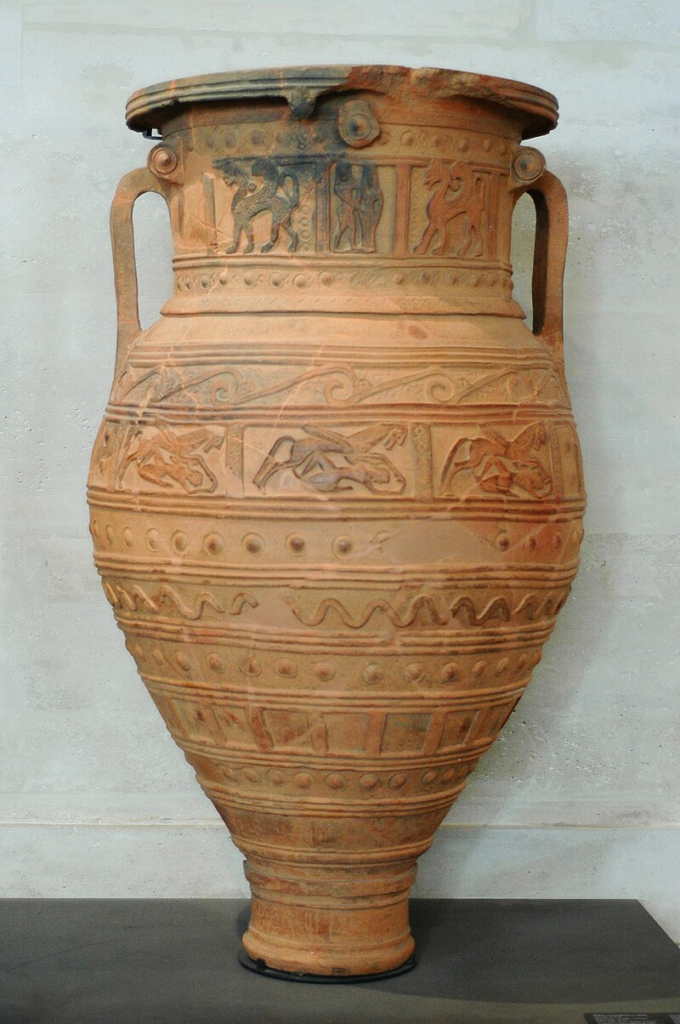
Is Woman a punishment to Man?
Is she woe to man?
A bit of a harsh assessment.

A man is a human being who works and no matter what a particular man does or how he spends his day, he has one thing in common with all other men:
He spends his day in a degrading manner.
No matter what a man’s job may be, every moment of his adult life will be spent as a cog in a huge and pitiless system designed to exploit him to his utmost, to his dying day.
We have long ceased to play the games of childhood.
As children, we become bored quickly and change from one game to another.
A man is like a child condemned to play the same game forever, for as soon as he is discovered to have a gift for one thing he is made to specialize.
Because he can earn more money in that field than another, he is forced to do it forever.
He will never be permitted to look for something else, because a man who changes his way of life, who changes his profession, is considered unreliable.
Do it more than once and become an outcast, abandoned and alone.
And this fear of being rejected by society compels men to spend their lives doing the same series of conditioned reflexes, again and again and again.
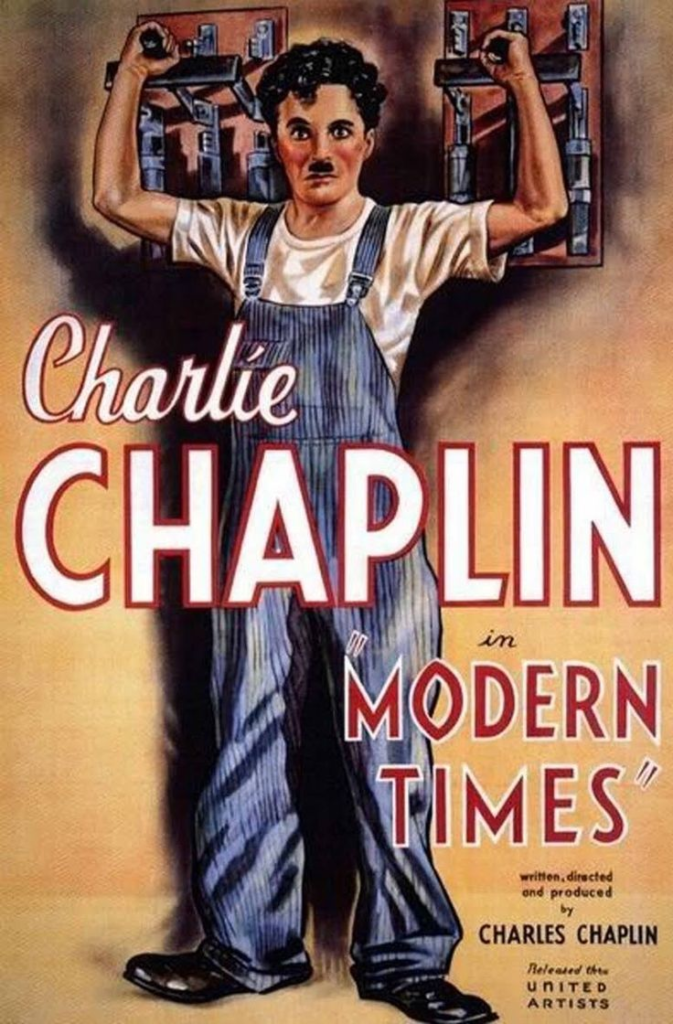
Men love women, but sometimes men have difficulty respecting women who are simply uninterested in conquering new worlds themselves.
If women seek equality they need to show equal ambition, an equal thirst for knowledge and an equal drive to prove themselves.
But since an animal dependence does not demand ambition, knowledge or drive, some women have chosen a different path.
For them, it is better to let men think that they are King of the Castle, to lean and depend on them, and continue to control and manipulate them as generations of women have done before.
Only Woman can break the vicious circle of man’s manipulation and exploitation, but She will not do it, for there is absolutely no compelling reason for Her to do so.
In the West, women have been given every opportunity to win their independence.
But some women have chosen as their ideal a life without work or responsibility.

We need more women like Kamala Harris and fewer like Pamela Anderson.

Above: American Vice-President Kamala Harris

Above: Canadian-born American model Pamela Anderson
Stupid girl
Stupid girls
Stupid girls
Maybe if I act like that
That guy will call me back
Porno paparazzi girls
I don’t wanna be a stupid girl
Go to Fred Segal, you’ll find them there
Laughing loud, so all the little people stare
Looking for a daddy to pay for the champagne
Droppin’ names

Above: Logo of American clothing retailer Fred Segal
What happened to the dream of a girl President
She’s dancing in the video next to 50 Cent
They travel in packs of two and three
With their itsy-bitsy doggies and their teeny-weeny tees

Above: American rapper Curtis James Jackson III (aka 50 Cent)
Where, oh where, have the smart people gone?
Oh where, oh where could they be?

Maybe if I act like that
That guy will call me back
Porno paparazzi girls
I don’t wanna be a stupid girl
Baby, if I act like that
Flippin’ my blond hair back
Push up my bra like that
I don’t wanna be a stupid girl

Break it down now
The disease is growing, it’s epidemic
I’m scared that there ain’t a cure
The world believes it, and I’m going crazy
I cannot take anymore
I’m so glad that I’ll never fit in
That will never be me
Outcasts and girls with ambition
That’s what I wanna see (come on)
Disaster’s all around (disaster’s all around)
A world of despair (a world of despair)
Your only concern, “Will it f… up my hair?“
Maybe if I act like that
That guy will call me back
Porno paparazzi girls
I don’t wanna be a stupid girl
Baby, if I act like that
Flippin’ my blond hair back
Push up my bra like that
I don’t wanna be a stupid girl
Thing, do ya thing
Do ya thing, do ya thing, yeah
I like this, like this, like this
Pretty, will you f… me, girl? (Silly, I’m so lucky girl)
Pull my hair, I’ll suck it, girl (stupid girl)
Pretty, will you f… me, girl? (Silly, I’m so lucky girl)
Pull my hair, I’ll suck it, girl (stupid girl)

Maybe if I act like that (baby, if I…)
Flipping my blond hair back (baby, if I…)
Push up my bra like that
Stupid girl
Maybe if I act like that
That guy will call me back
Porno paparazzi girls
I don’t wanna be a stupid girl (stupid girl)
Maybe if I act like that
Flippin’ my blond hair back
Push up my bra like that
I don’t wanna be a stupid girl (stupid girl)
Maybe if I act like that (stupid girl)
Flipping my blond hair back (stupid girl)
Push up my bra like that (stupid girl)
Stupid girl
Stupid girl (stupid girl)
Stupid girl (stupid girl)
Stupid girl (stupid girl)…

Theoretically it is possible for a beautiful woman to have less intelligence than a chimpanzee and still be considered an acceptable member of society.
Were it not for a man’s desire for a woman’s booty and beauty there would be little for some women to offer men.

Life offers the human being two choices:
Animal existence or spirıtual existence.
Men and women have the same intellectual potential, but, unlike men, women’s personal development is not crucial to their survival.
The one great advantage women have over men is that they have a choice.
Women could save humanity if they would only save themselves first…
If only women would live up to the same standards that they want men to adhere to…

If men used their intelligence and imagination for the creation of new worlds rather than the preservation and improvement of the old…
If composers created something other than “silly love songs“…

If writers gave up their Quixotic quest to entertain women with romantic novels and instead wrote literature…
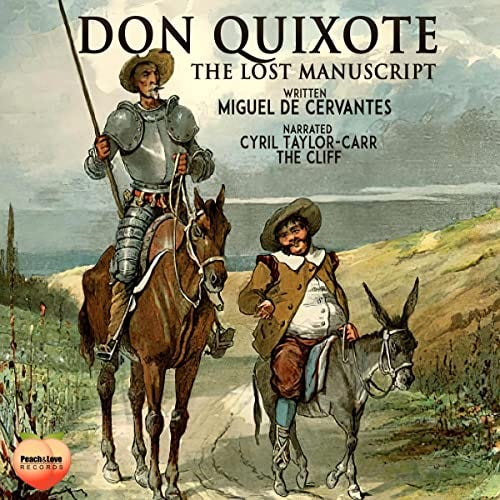
If painters painted more than nudes and profiles of women and instead created art…

If men would try living for themselves rather than for women….

“Liberty is one of the most valuable blessings that Heaven has bestowed upon mankind.”

“He got the better of himself and that’s the best kind of victory one can wish for.“
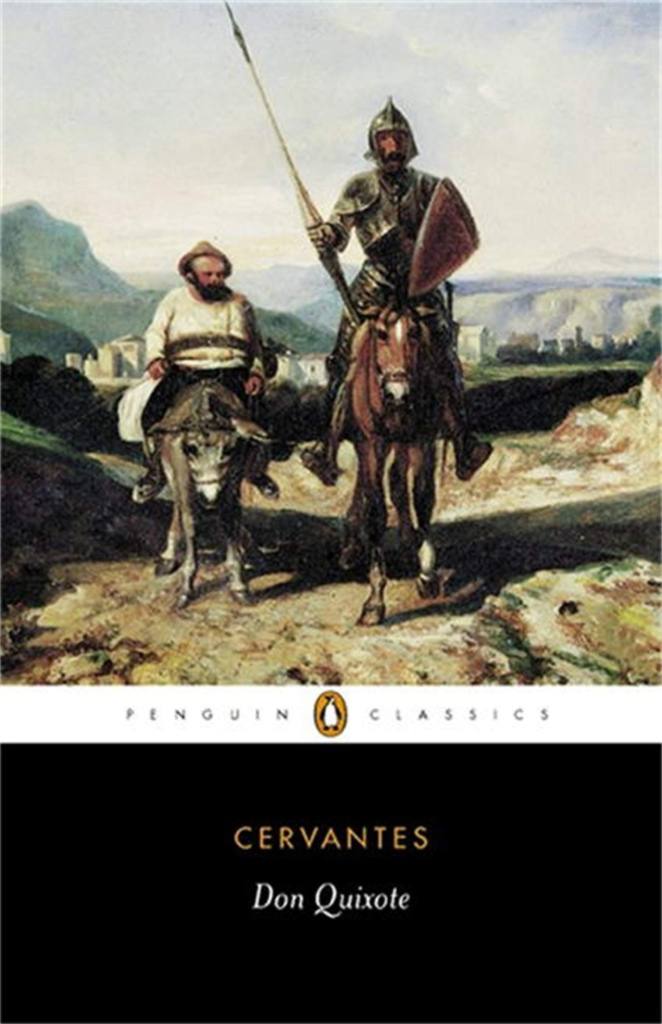
If men would stop waging wars to defend private property that women want….
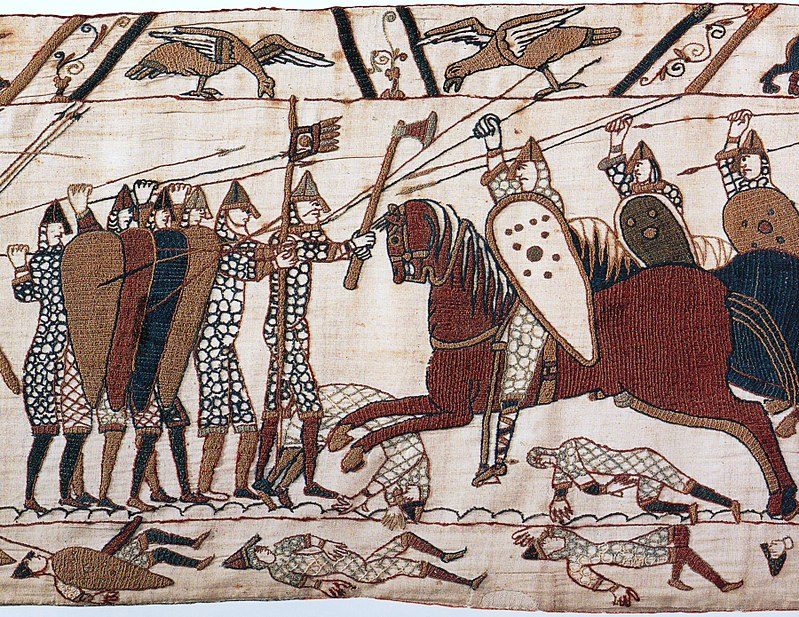
(More than half of total private capital is in the hands of women, some legitimately earned, some granted by divorce courts or last will and testament.)

We have placed our faith in the fairer sex in the hope that they will match men’s intelligence, imagination and determination on an equal footing instead of focusing on their worship of self with all its pomp and mummery, smoke and mirrors.
Has our faith been misplaced?

“And towering above each town, generally built on a height commanding it, stood the Church, its finger pointed to heaven, its masonry rich and heavy, permanent and menacing, a constant reminder of the domination of the Church down all the ages.
For although these deeply Catholic people had been burning their churches for centuries, the Church and its allies had always reasserted their power over the people, and this power was in dispute again to the endless hills, carved from root to summit with stone-shored terraces to hold the olives and the vine fields, quiet evidence of thousands upon thousands of grinding hours of man and woman labor.
Sunny Spain, land of mañana, where nothing was done today that could be put off till tomorrow!“
Alvah Bessie

Above: American writer Alvah Bessie (1904 – 1985)
Our hero decides what he feels today he can express mañana.
The Church of Woman is barren and bare.
The spirit of Woman is everpresent and everywhere.
As She continously makes demands, a man never feels forsaken.
She is a jealous deity and thus demands his total devotion.
He trusts in Her because She resembles his mother, the goddess of his childhood.
His empty life is given meaning, for his every action is dedicated to Her comfort and later the comfort of Her children.
She giveth (sex) and She taketh away (his sense of belonging and his worldly wealth).

“Those two fatal words, Mine and Thine.“
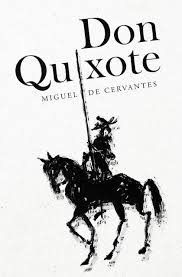
Her propensity for masquerade confuses men with its incomprehensibility.
We assume that She is strange and mysterious, but were She truly divine Her actions would be reasonable and logical, measurable, predictable, controllable.
Perhaps She is not as wise as she pretends to be, for so often her actions are unreasonable, unpredictable and uncontrollable.

“That’s the nature of women:
Not to love when we love them and to love when we love them not.“
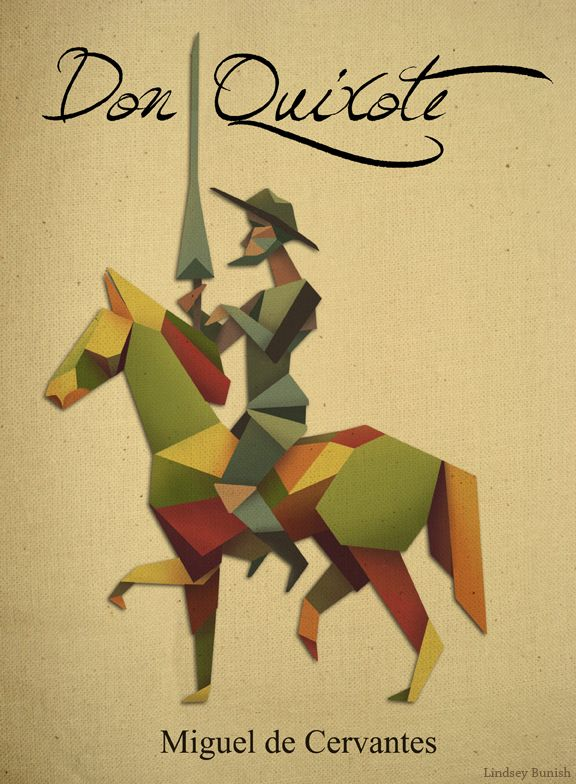
As I view the Tarasca, I ponder whether the Marian figure rides the seven-headed serpent or whether the serpent emerges from her.
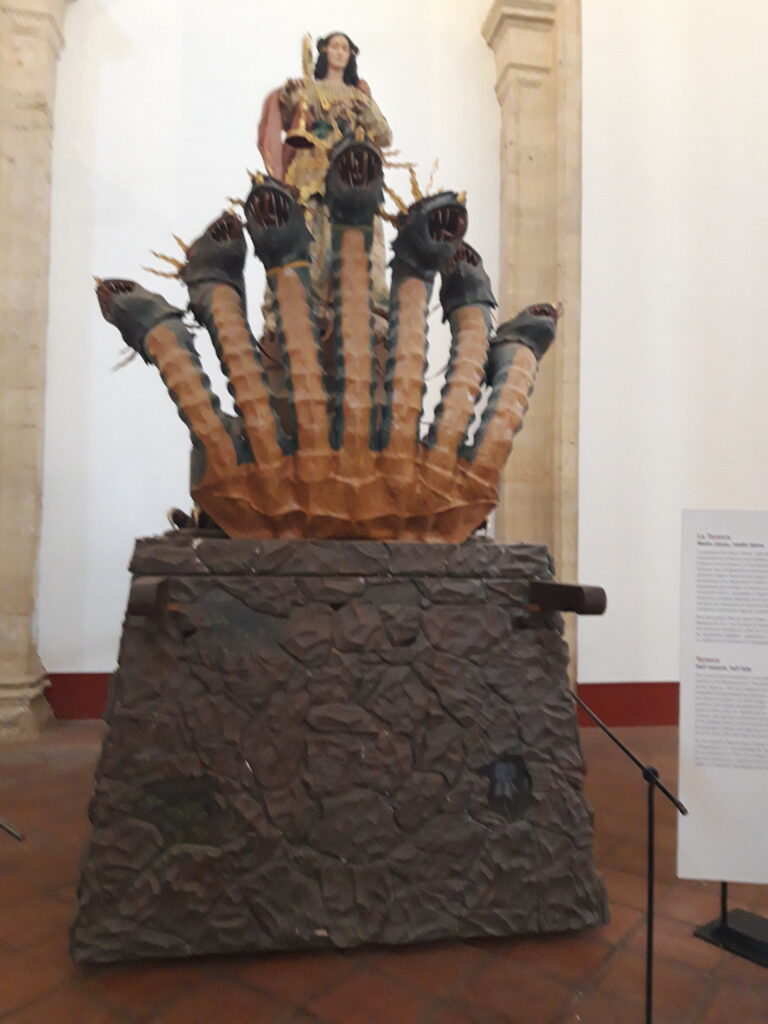
I do not share these thoughts with the Mrs., for I know that her preceptions will differ greatly from mine.
As I lack the oral combat skills of a woman, I remain silent.
I am a typically modern man.
I submit, mumble and tiptoe away.
I act conciliatory even when I am not at fault.

“Make it thy business to know thyself, which is the most difficult lesson in the world.”
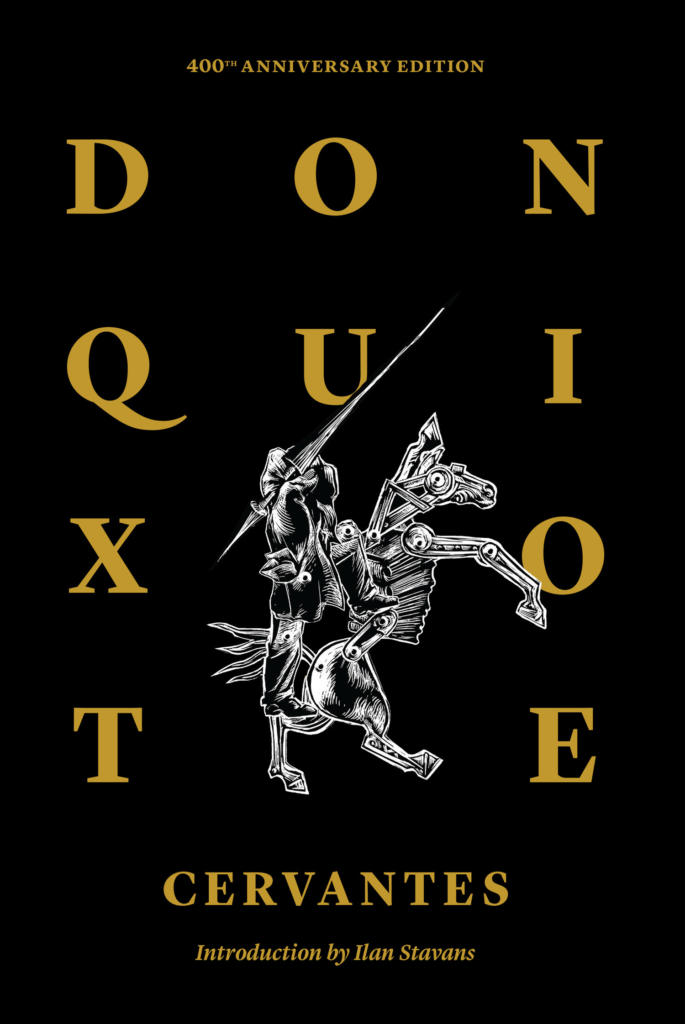
The dragons, the giants, are cleverly disguised windmills.
And what fool would joust with windmills?
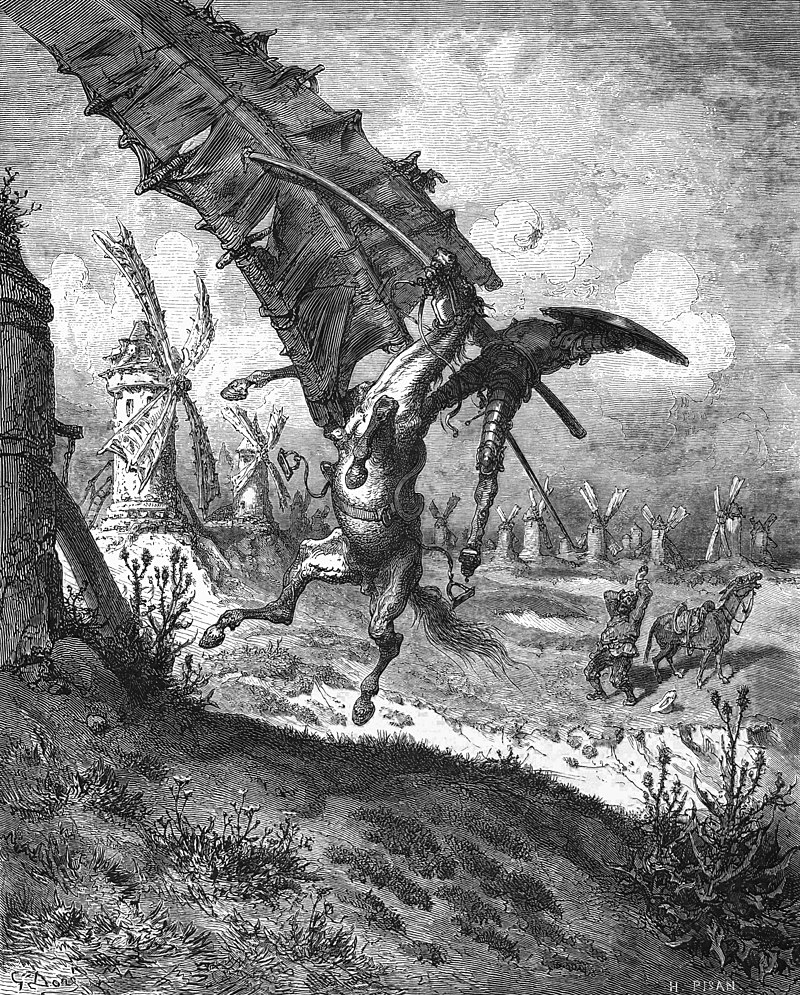
Above: The famous windmill scene, Don Quixote
“Take care, Your Worship, those things over there are not giants but windmills.“
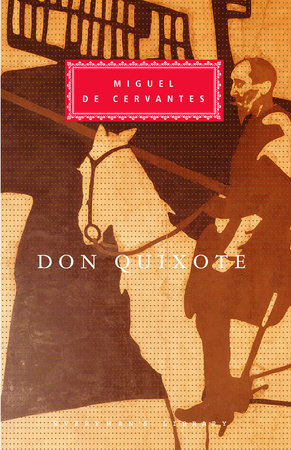
Better to defend Dulcinea, to see her as I choose to see her rather than see her as she really is.
The pretense prevails.
We have seen the Alcabaza and the church beneath.

“By a small sample we may judge of the whole piece.“
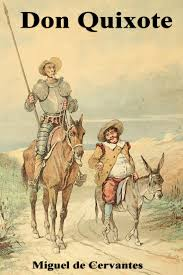
The journey continues.
Soon we will explore more of Antequera and then peer into the interior of dolmens and then continue on to Granada.
The sun sets.
The sun also rises.
“It is good to live and learn.“
“But all in good time.”
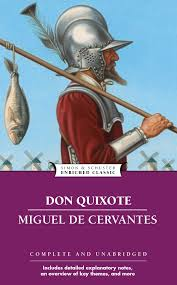
Sources:
Dave Allen, “Religion“
Jane Austen, Pride and Prejudice
Alvah Bessie, Men in Battle: A Story of Americans in Spain
Steve Biddulph, Manhood
Miguel de Cervantes, Don Quixote
Harry Chapin, “Cat’s in the Cradle“
Google Images
Lonely Planet Andalucia
Pink, “Stupid Girls“
Rough Guide to Spain
Esther Vilar, The Manipulated Man
Wikipedia